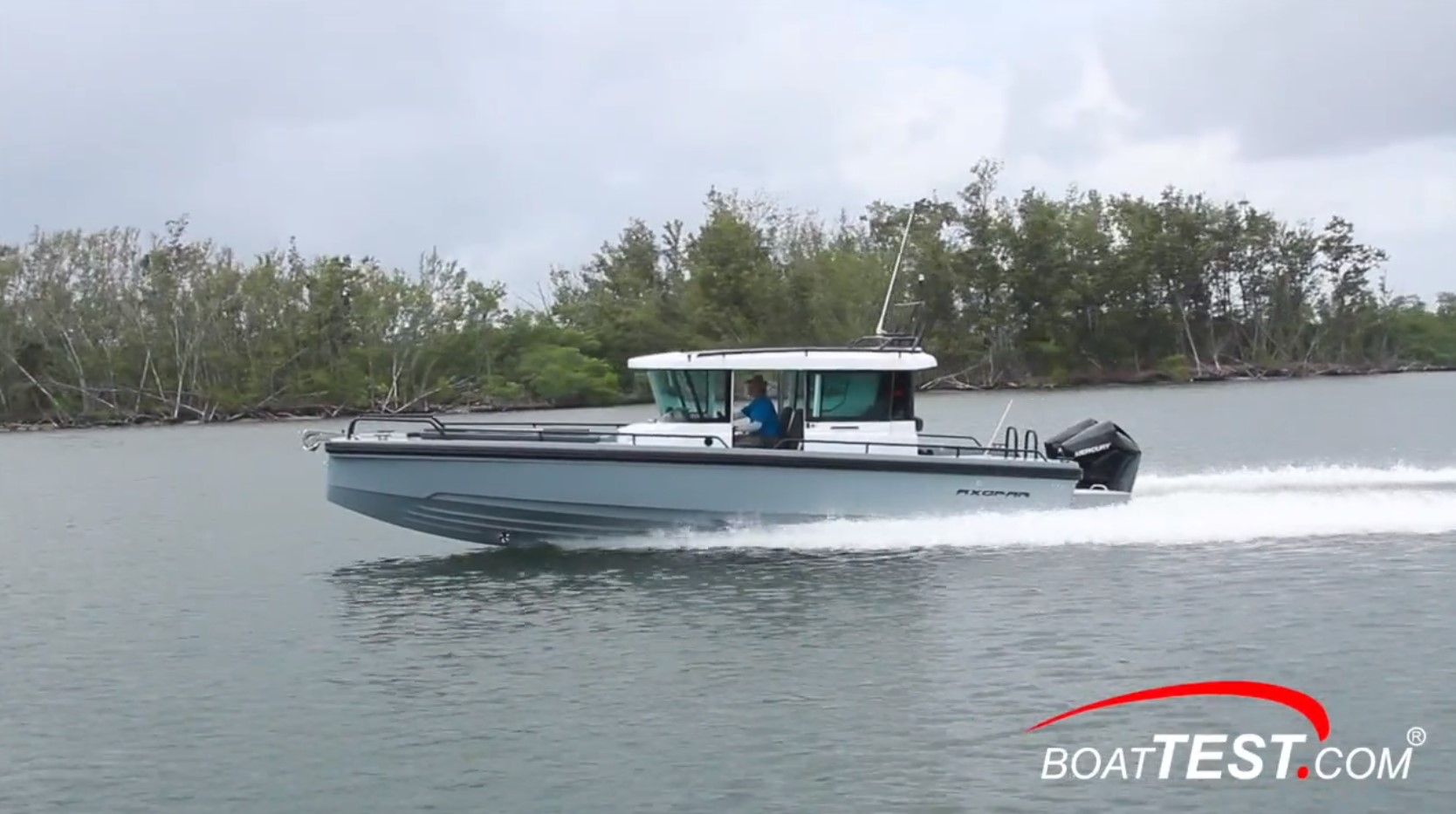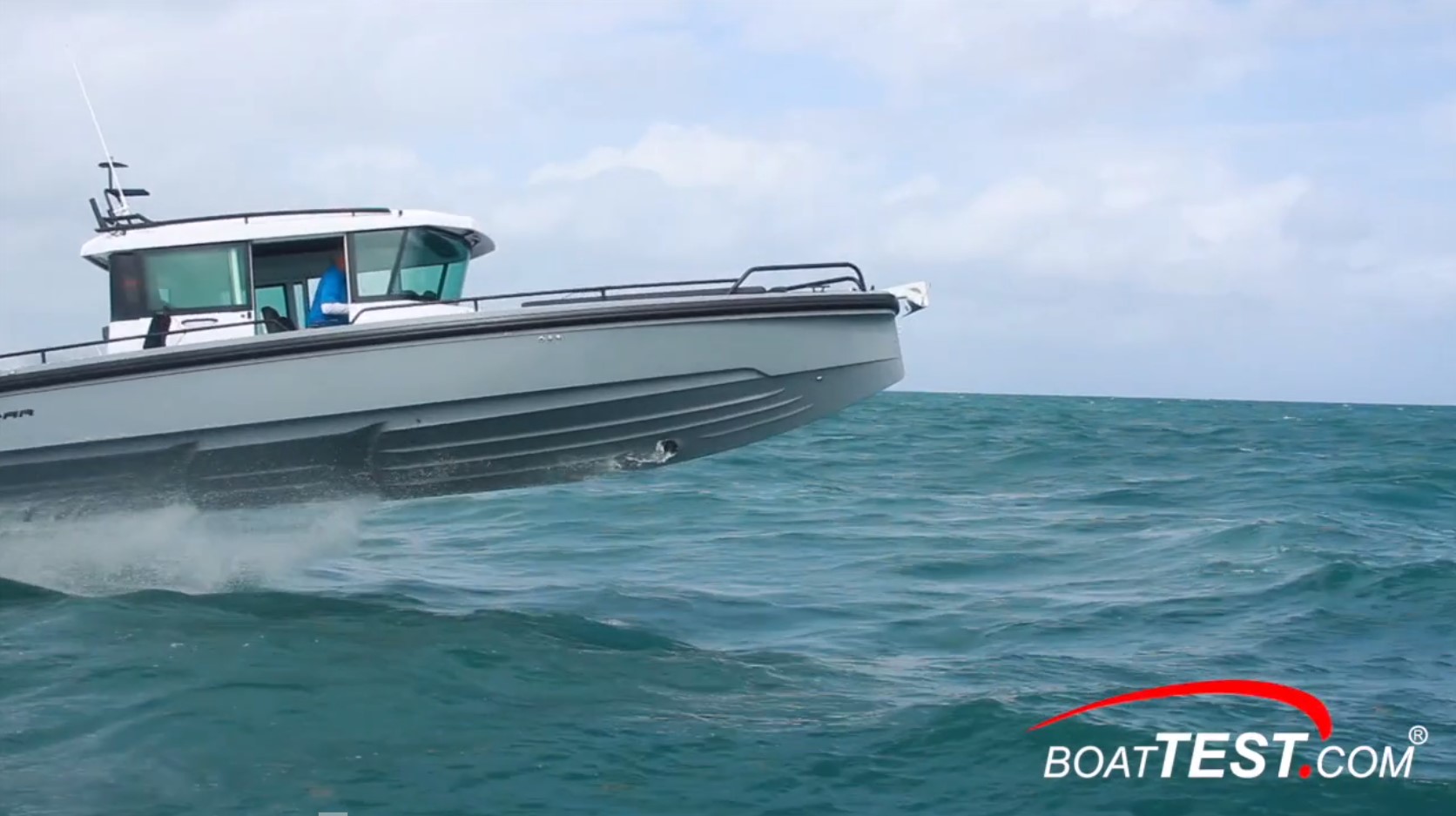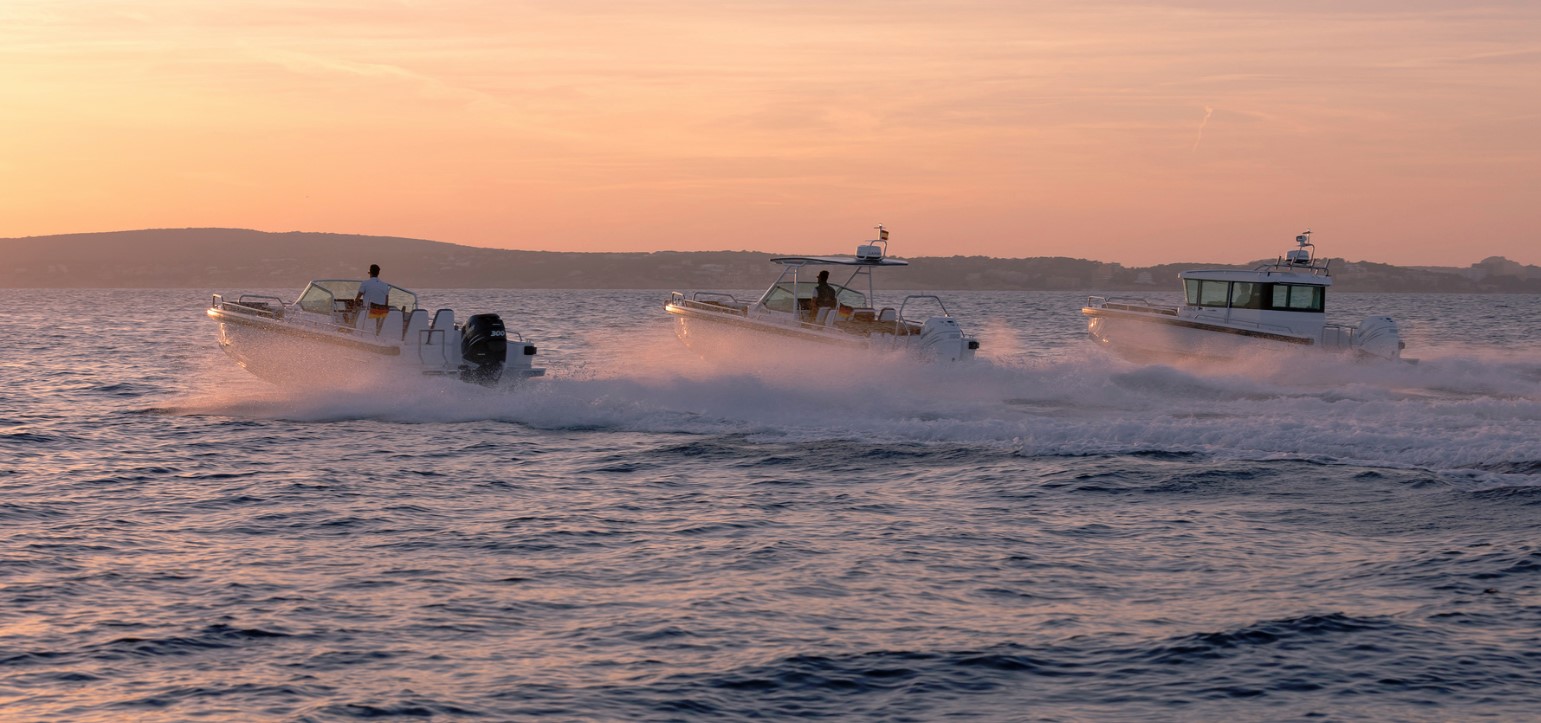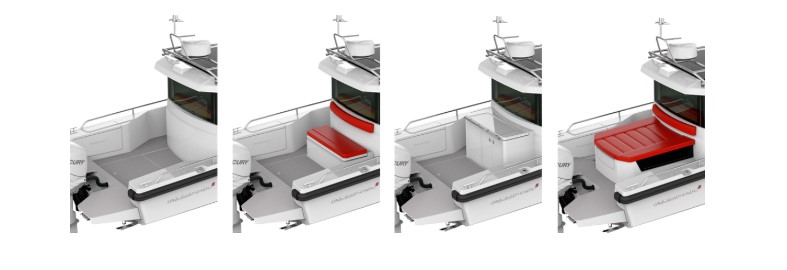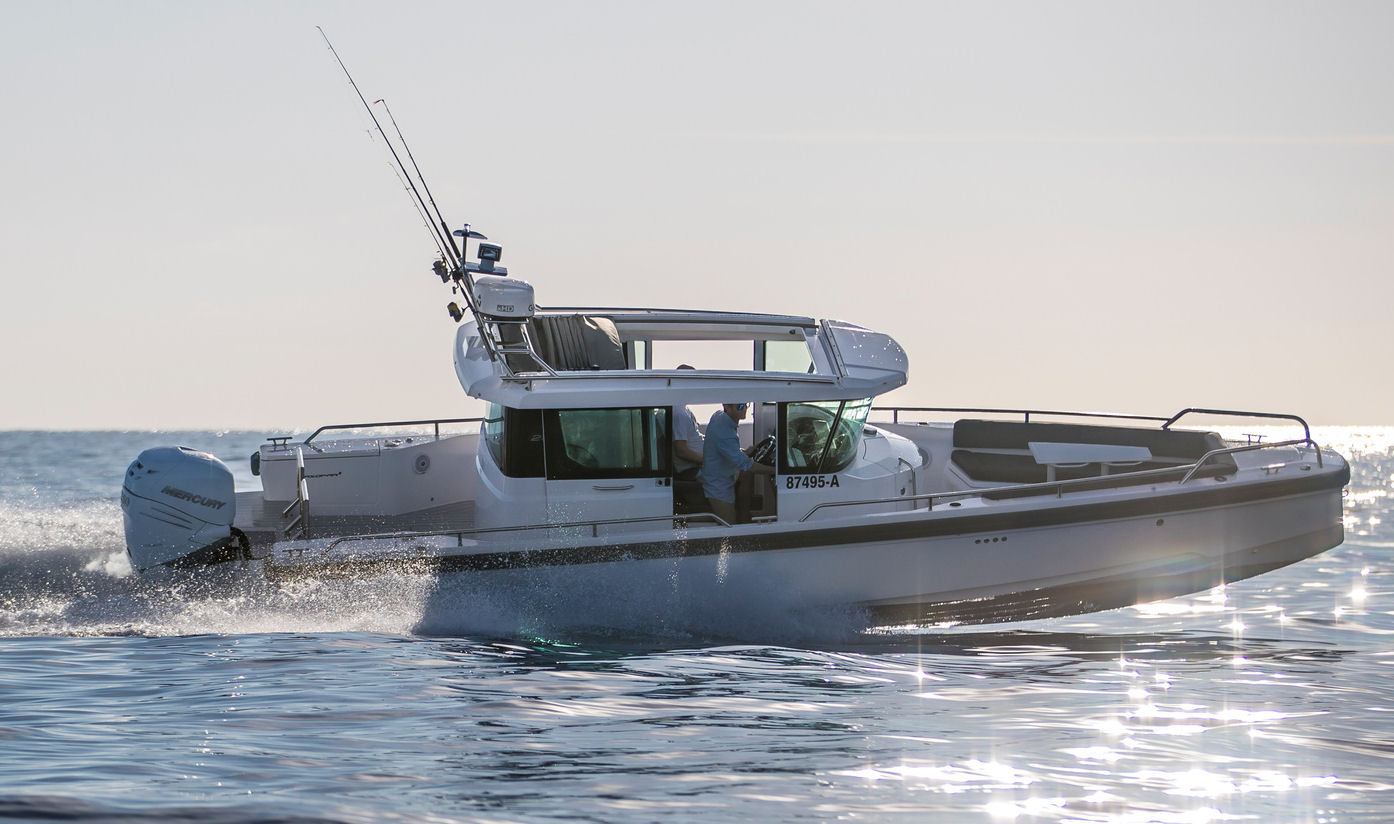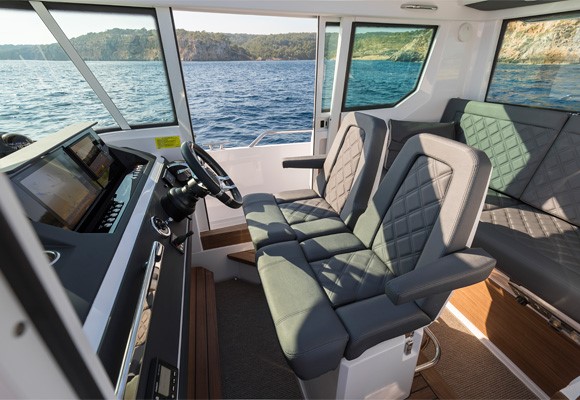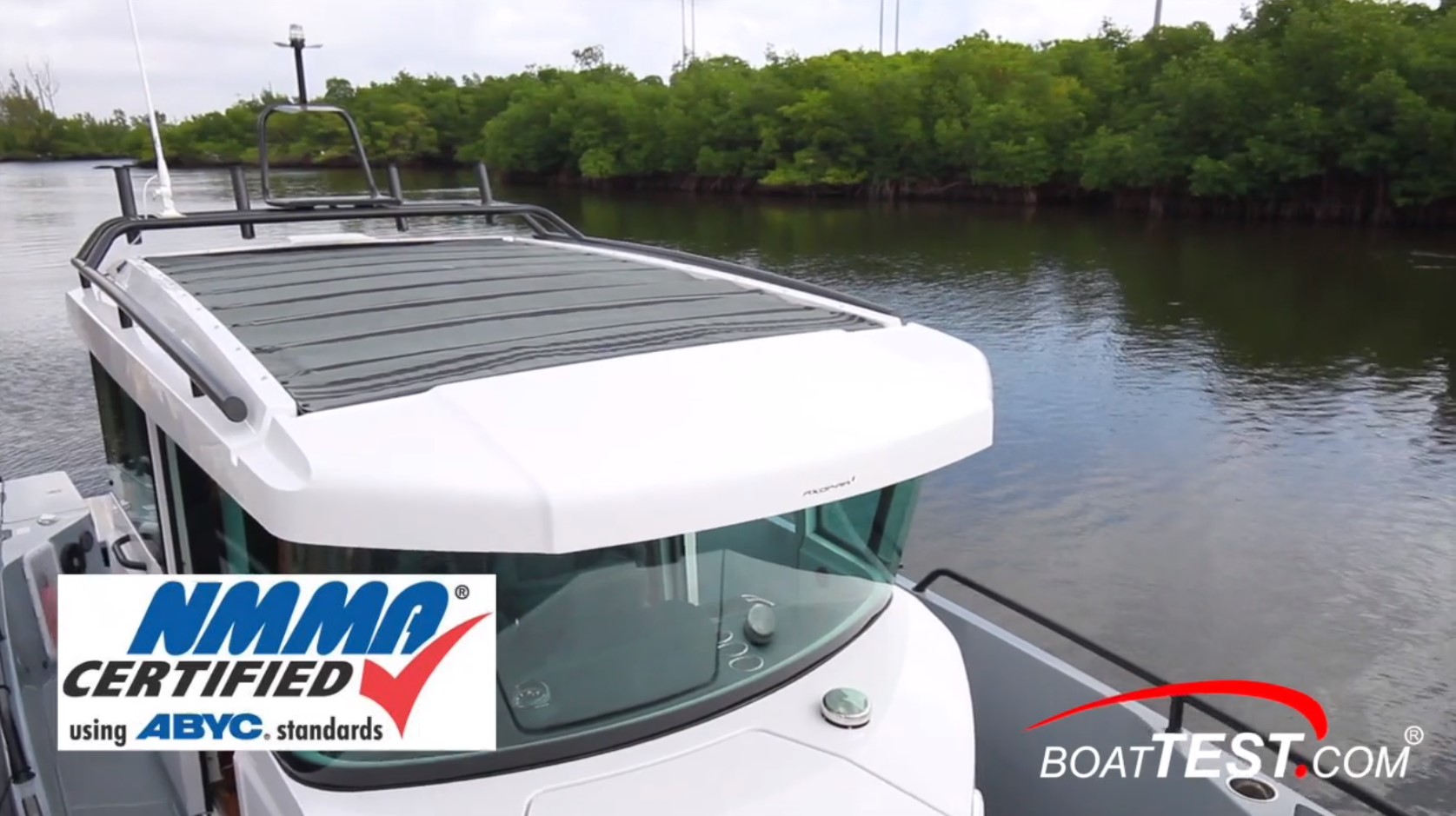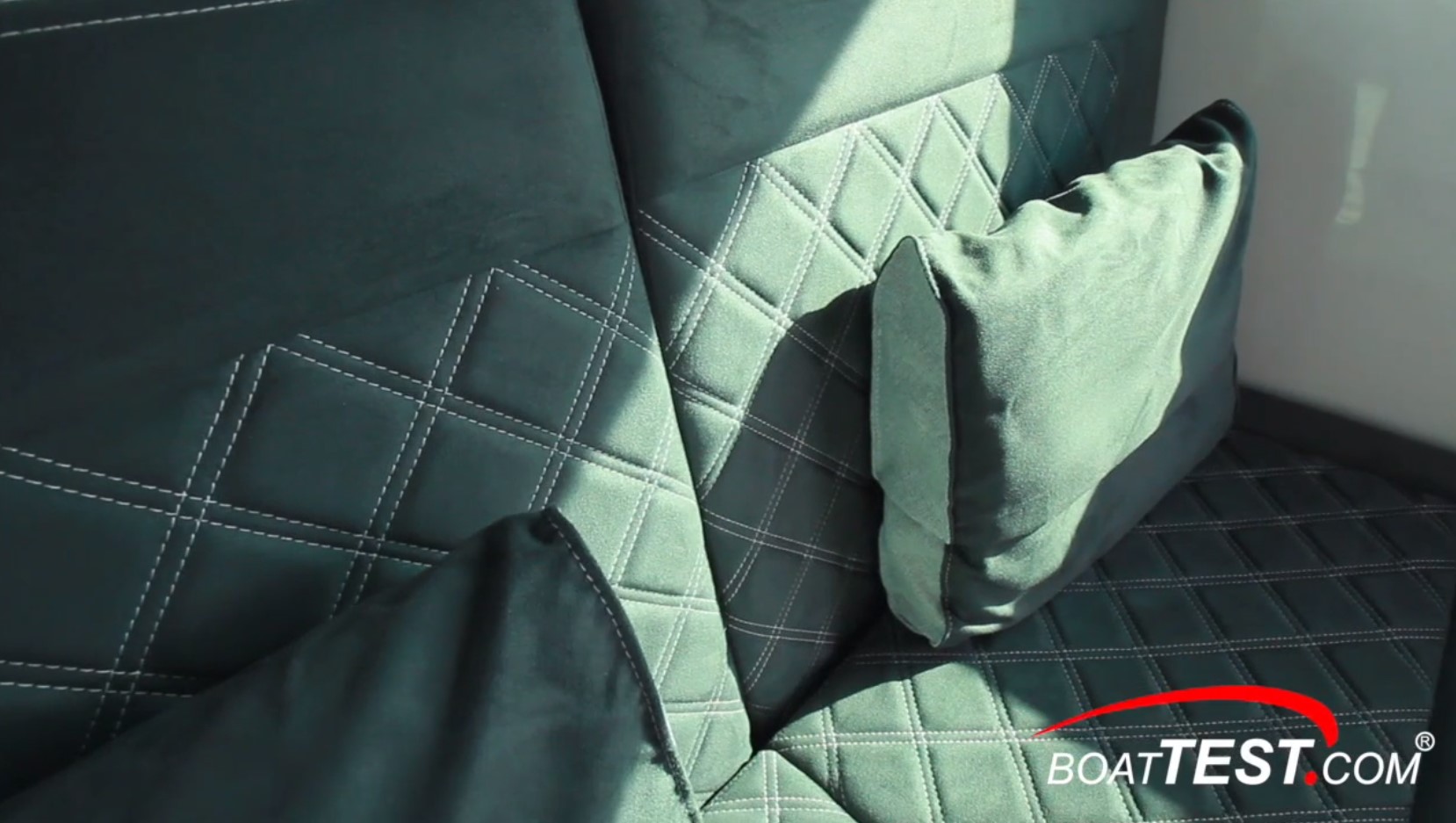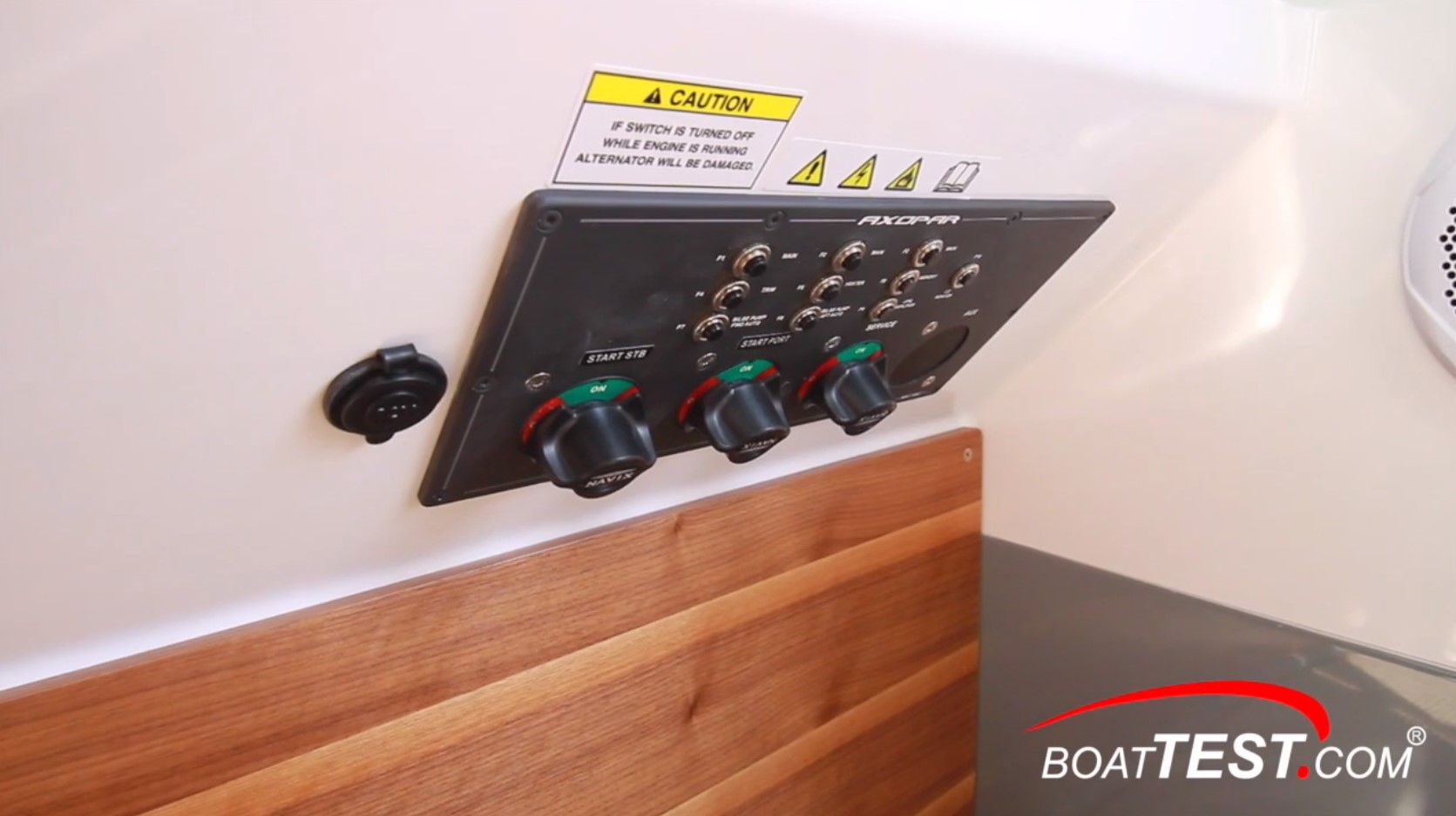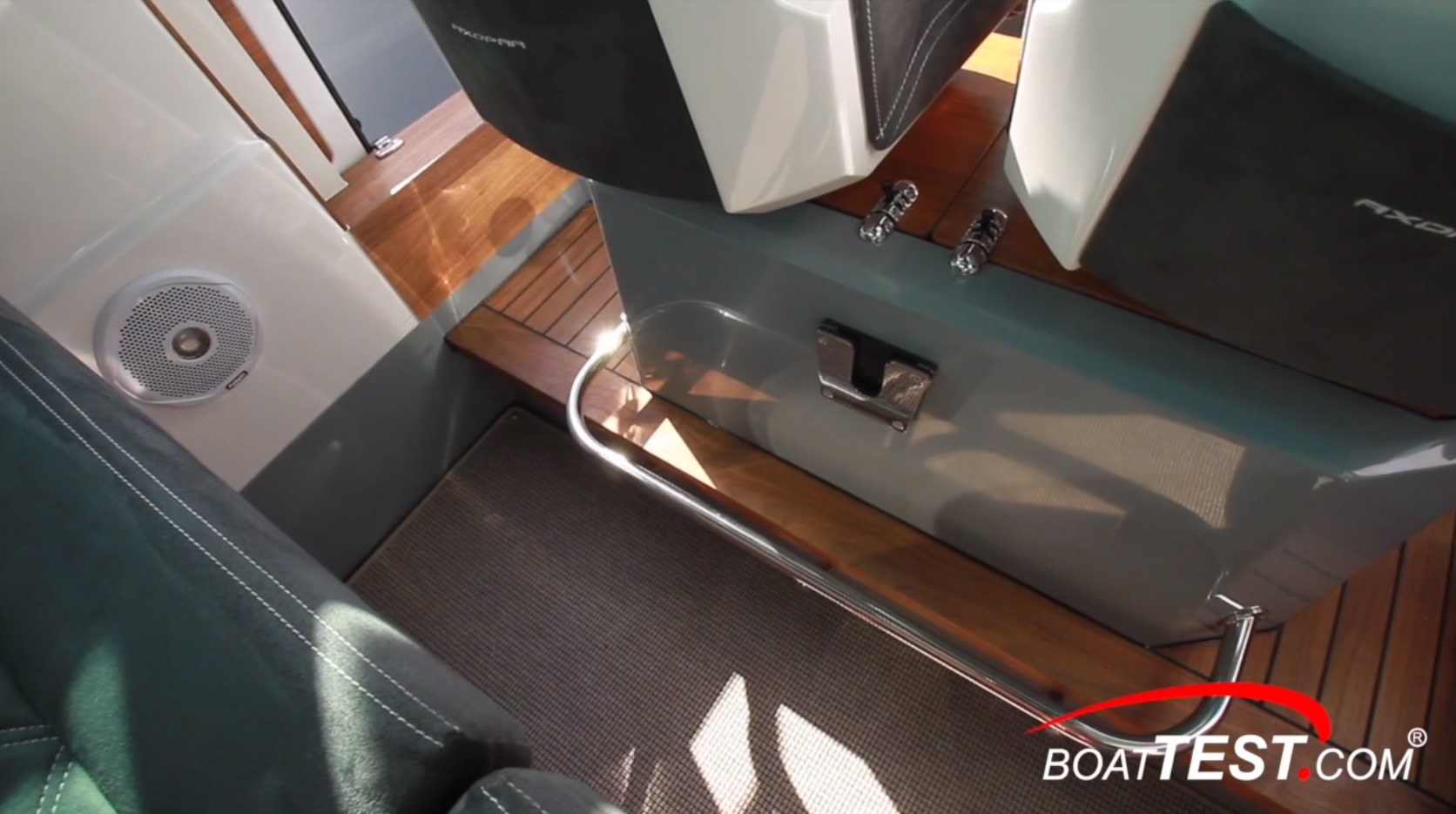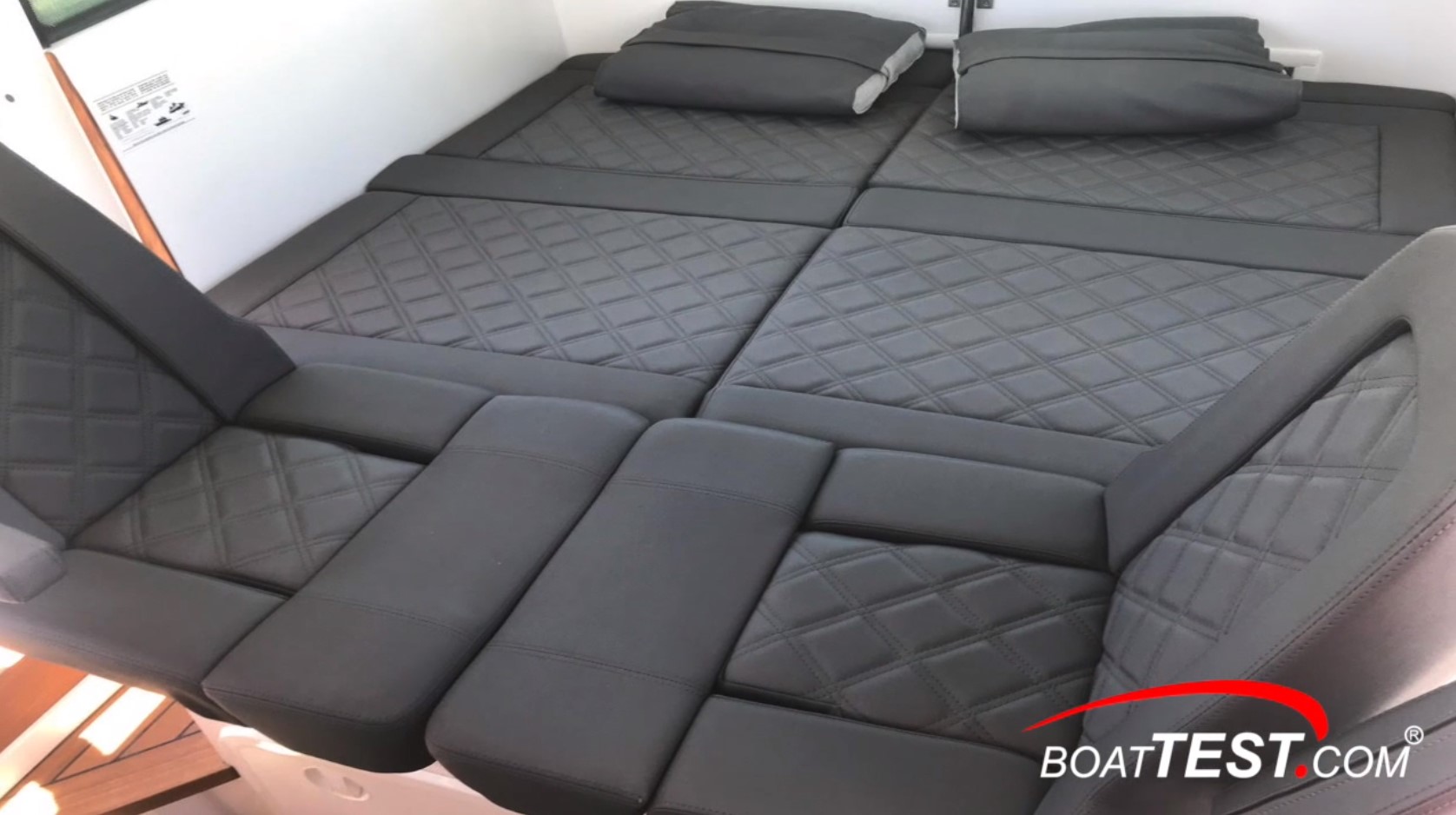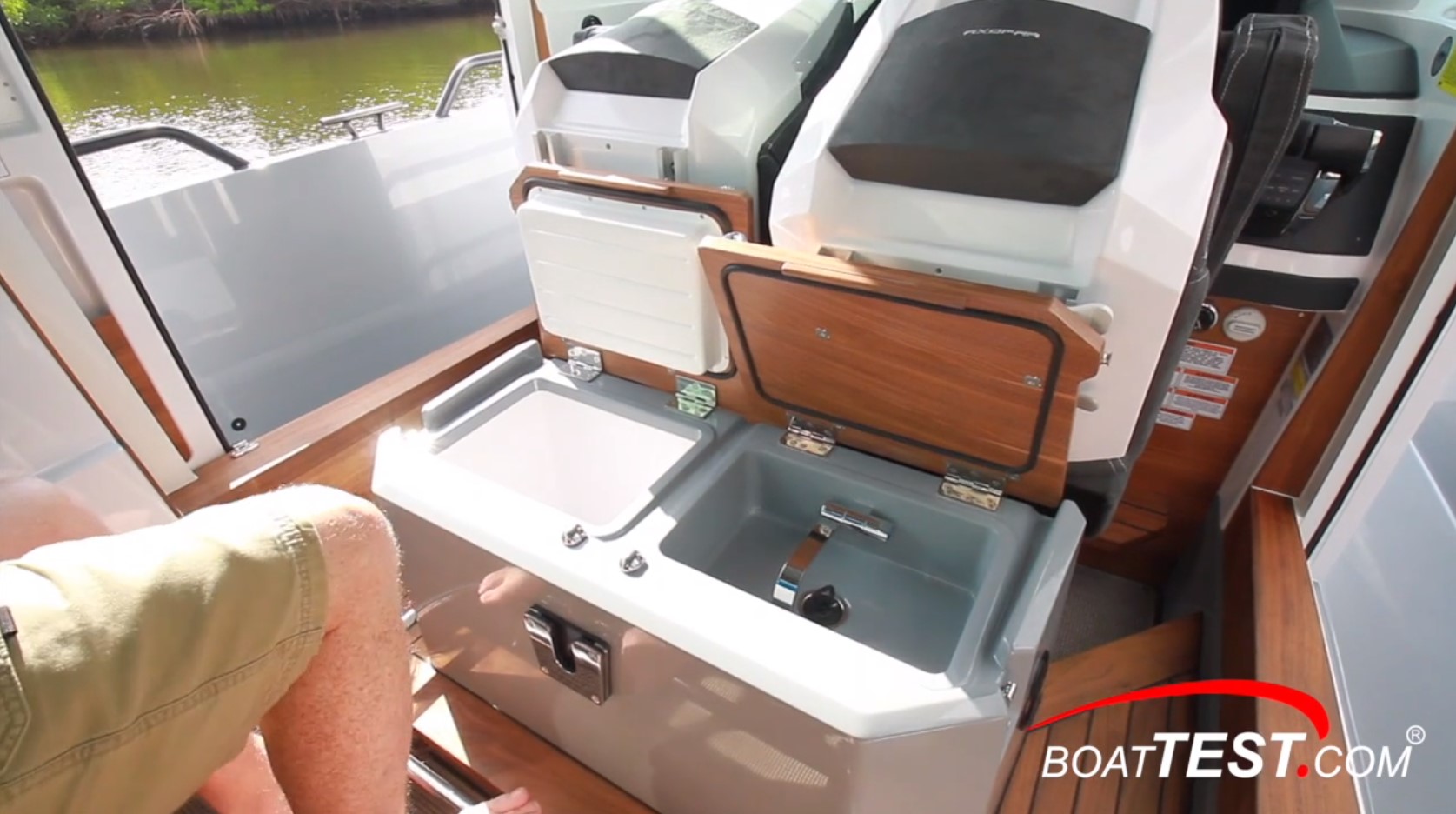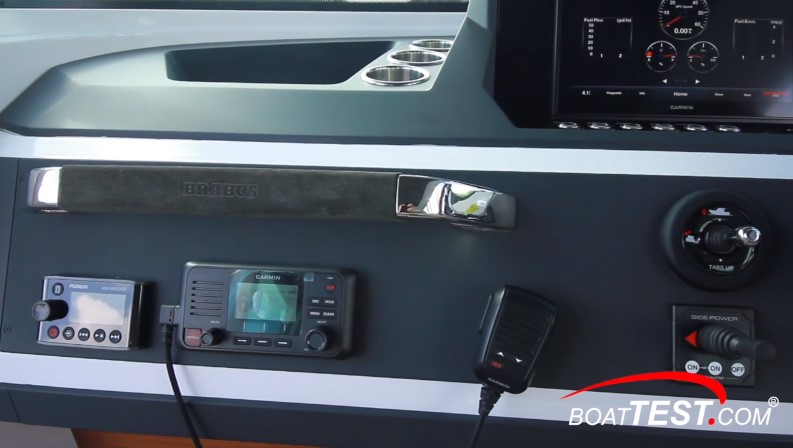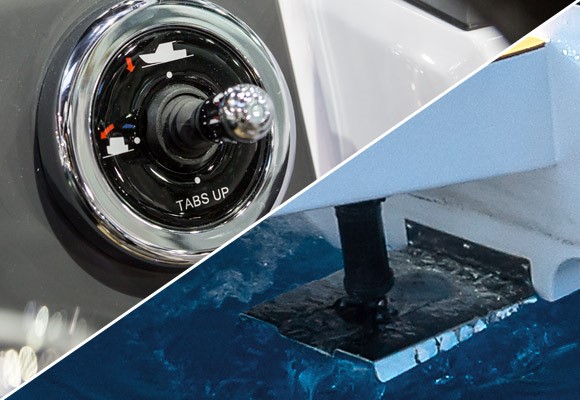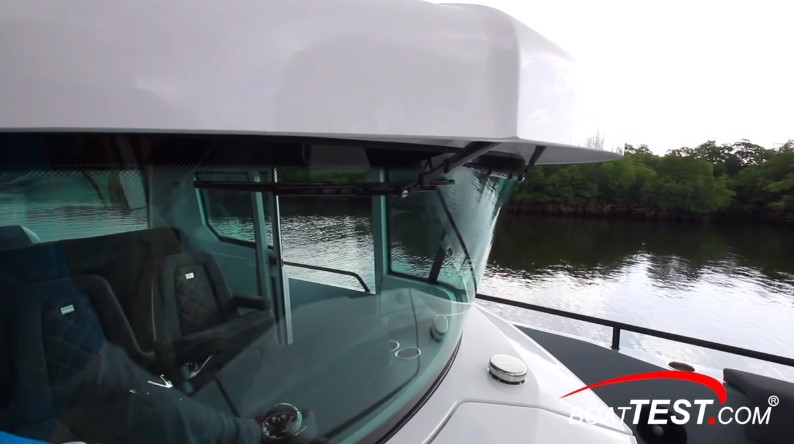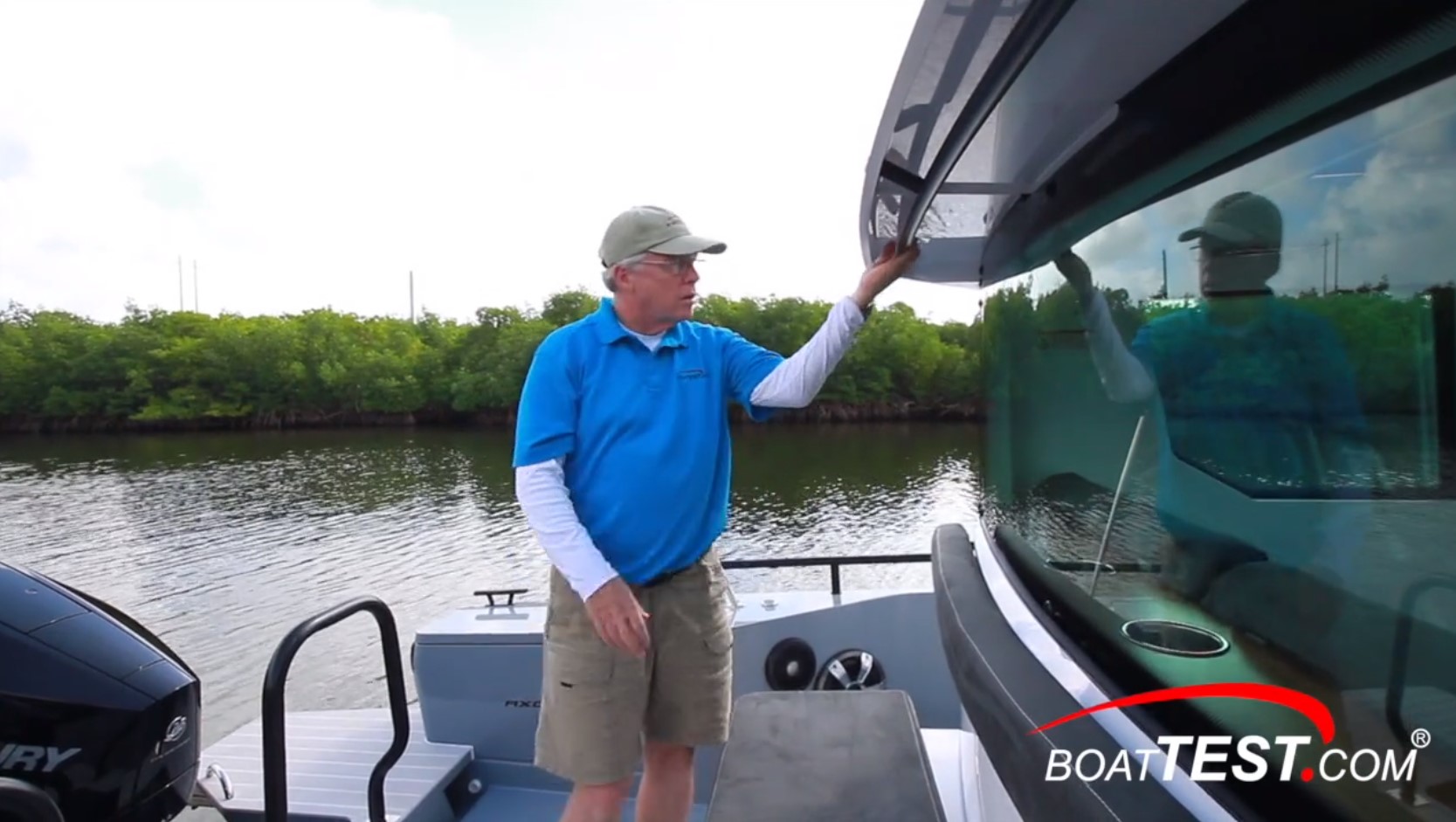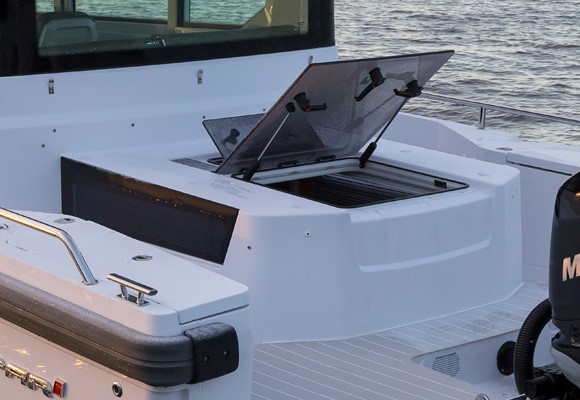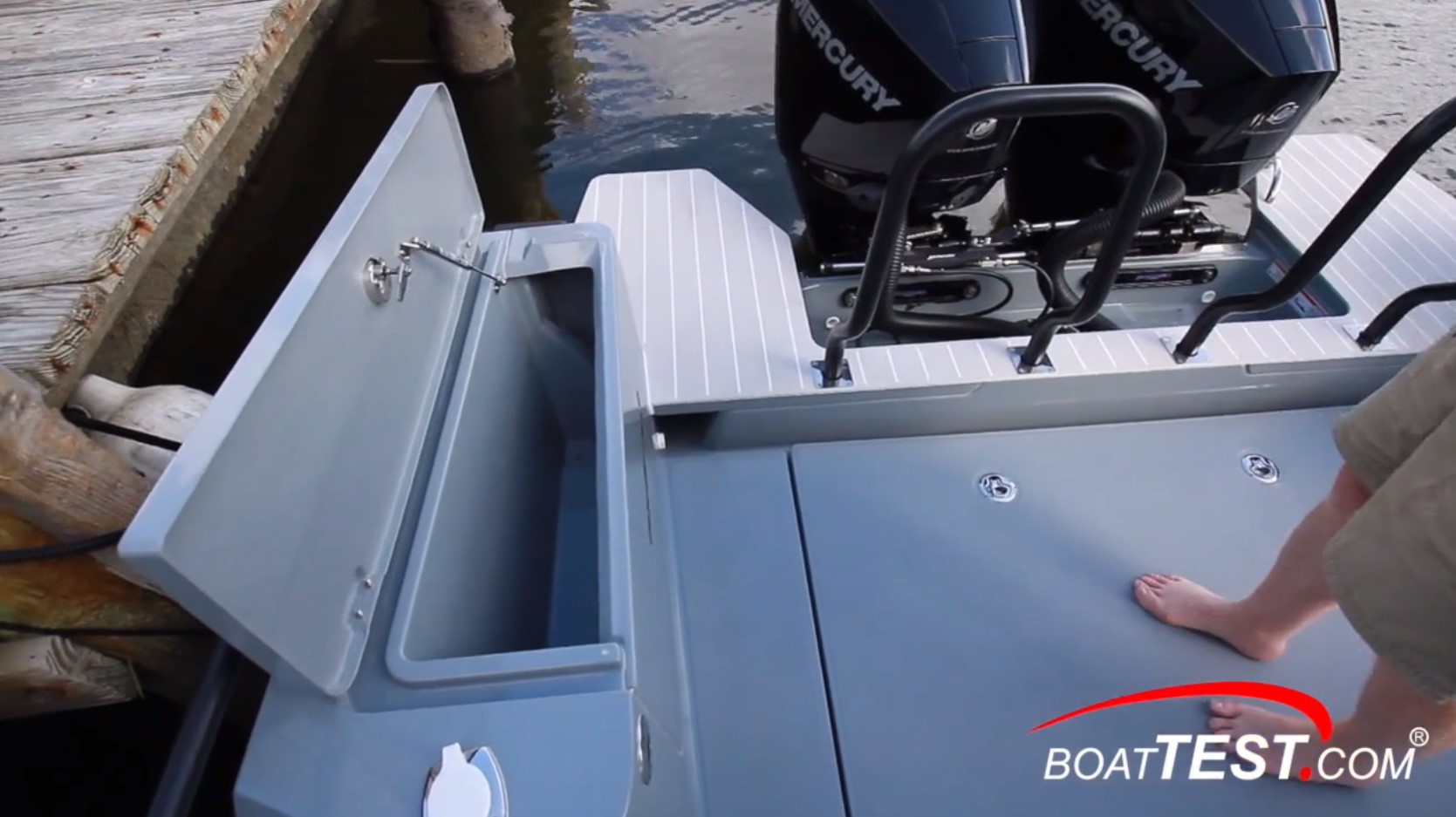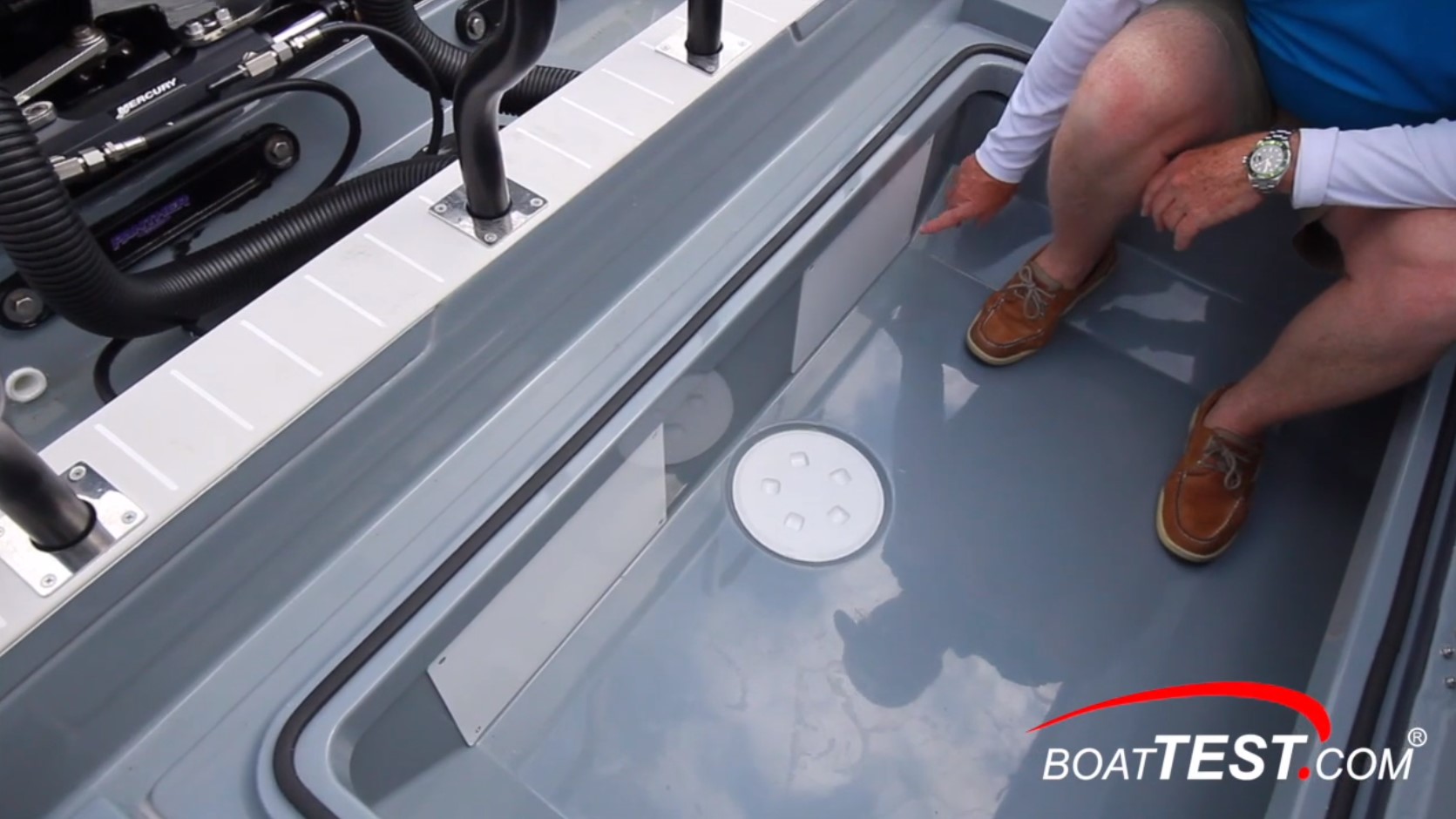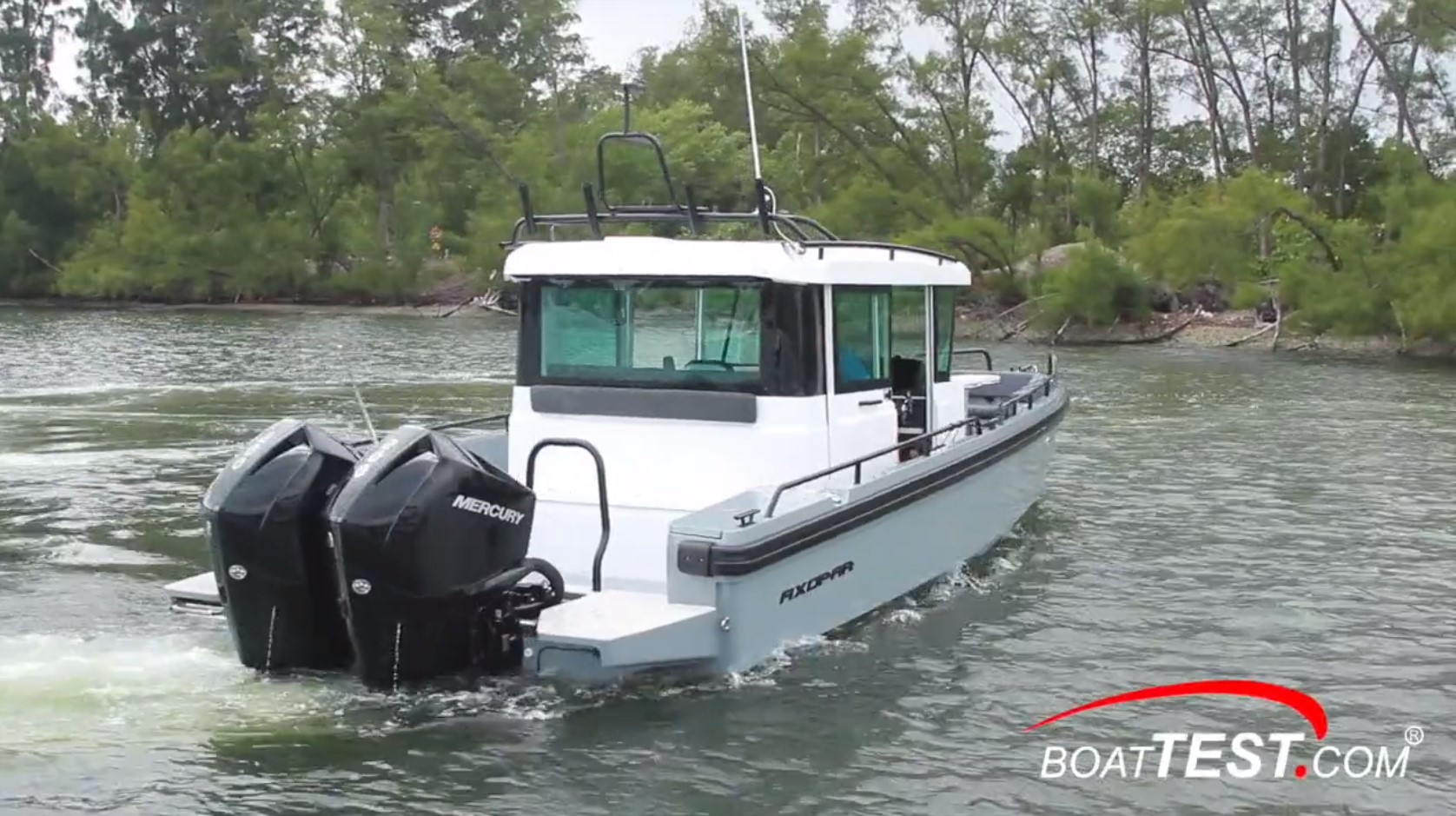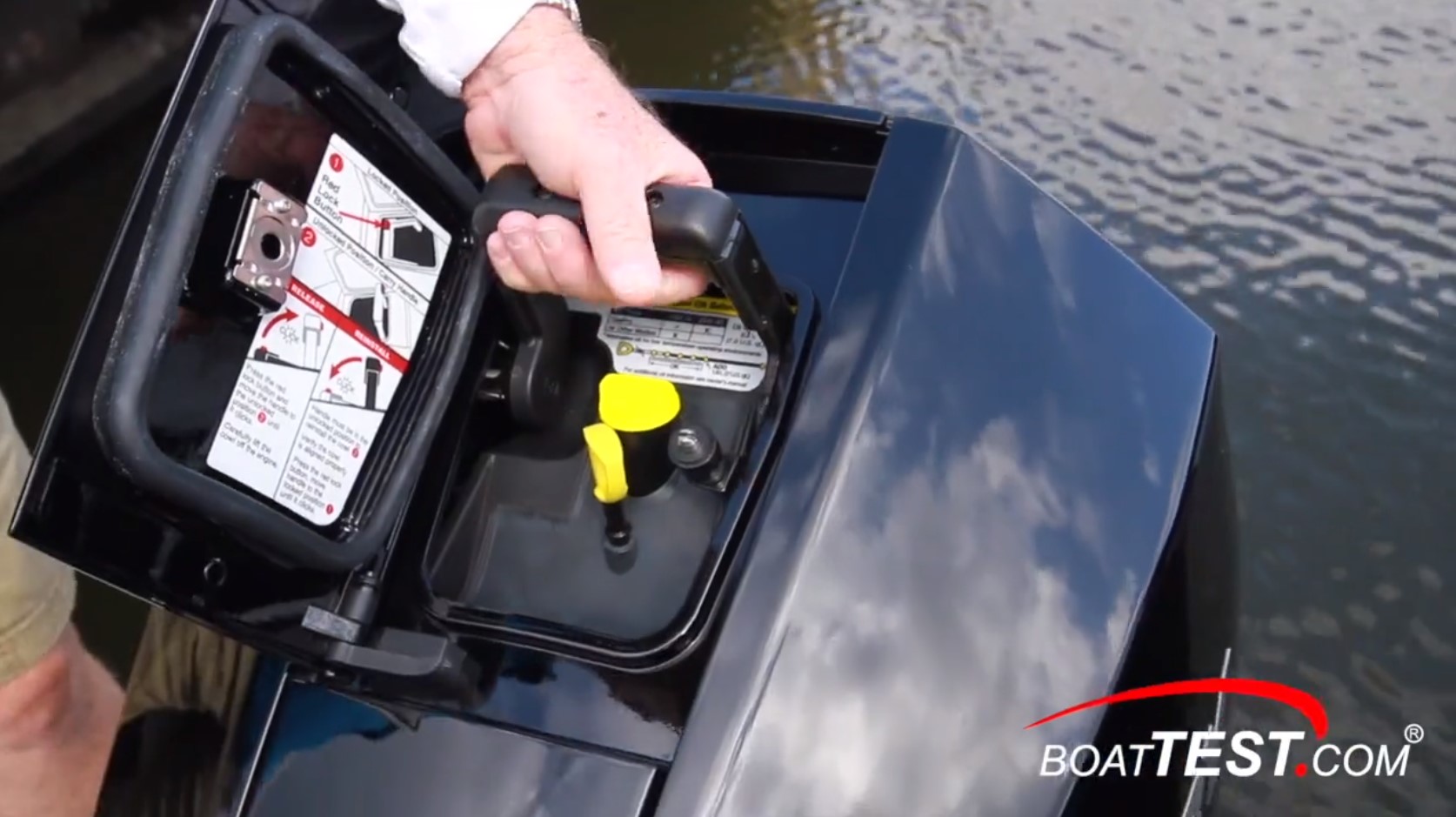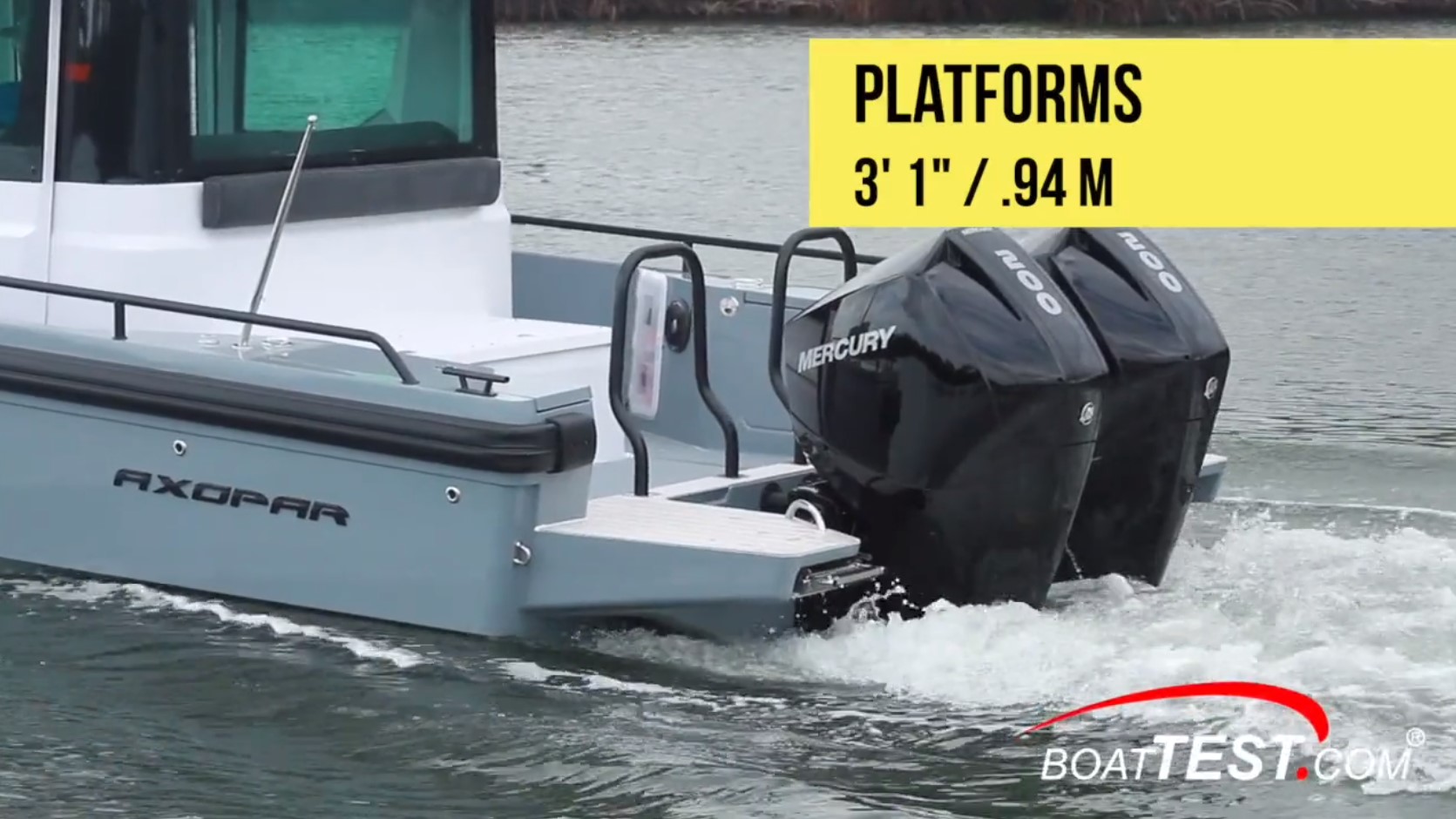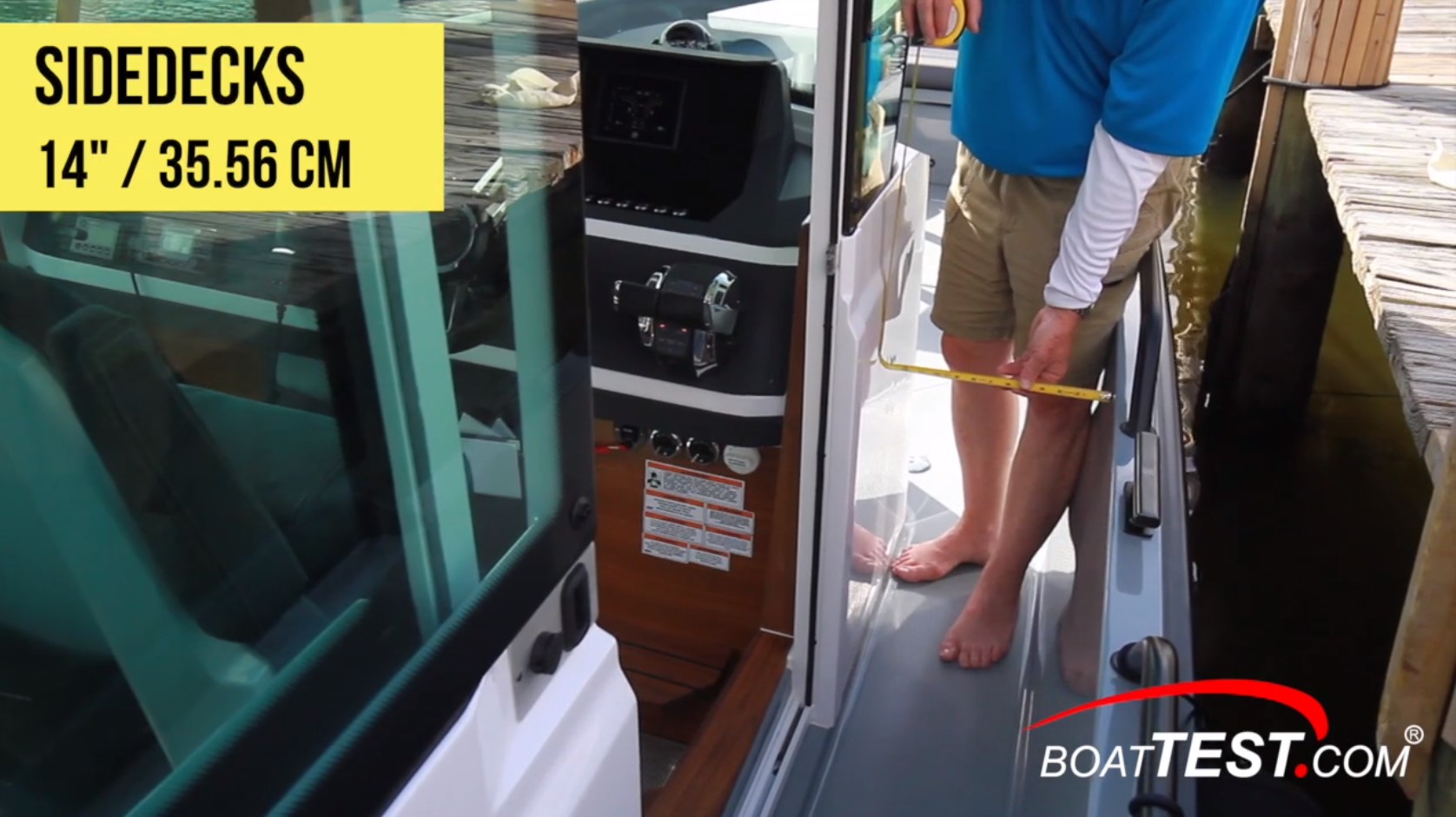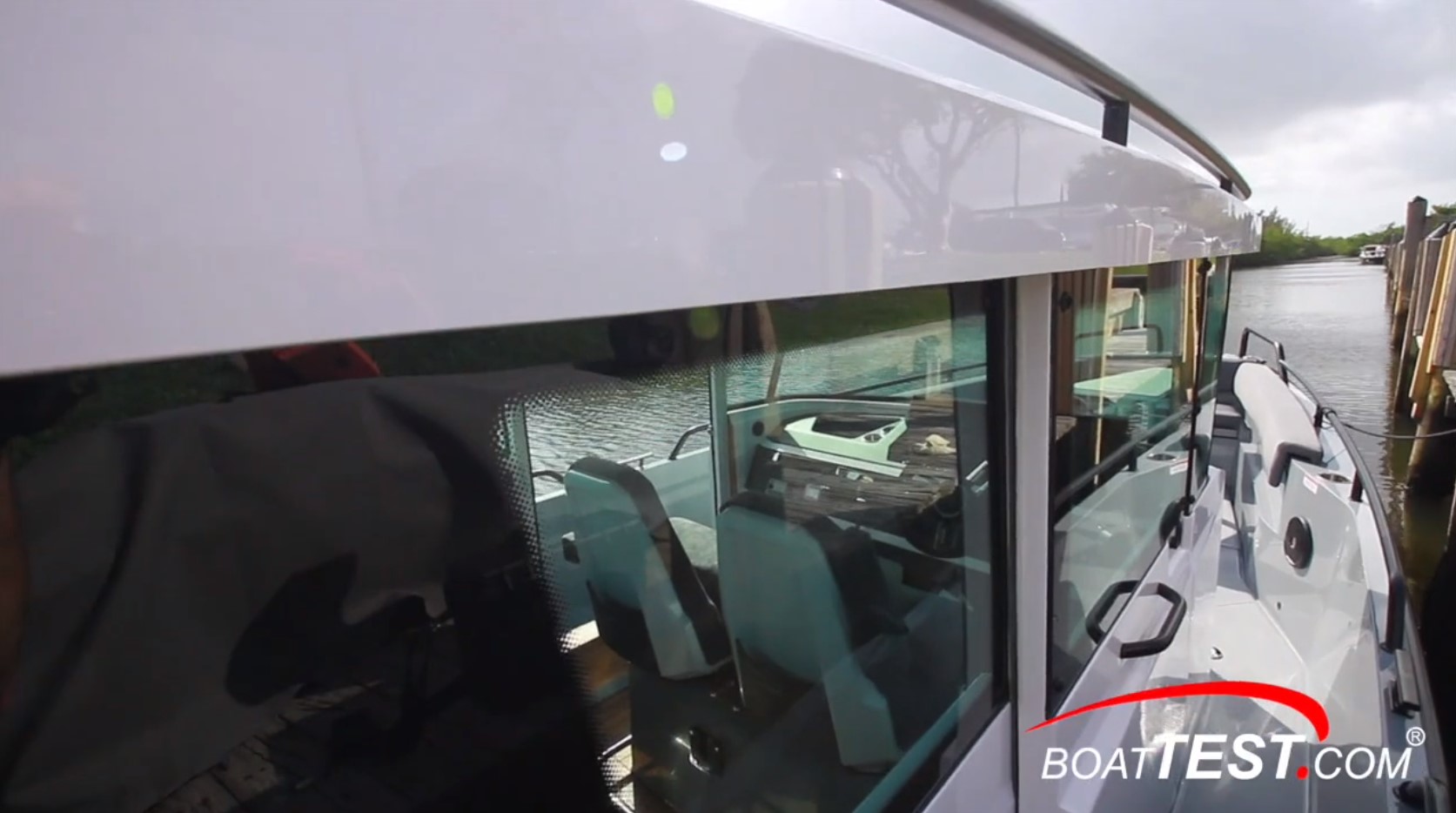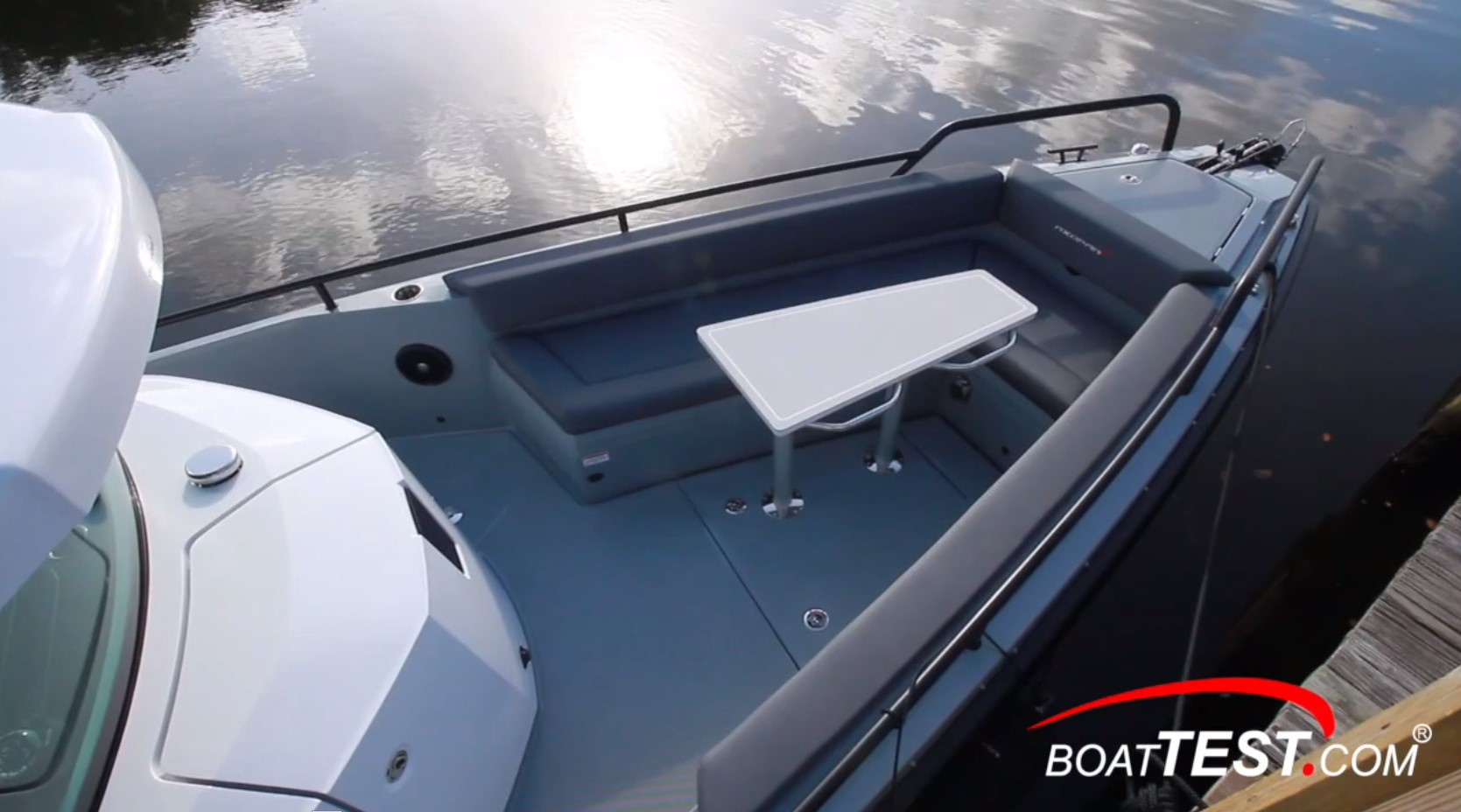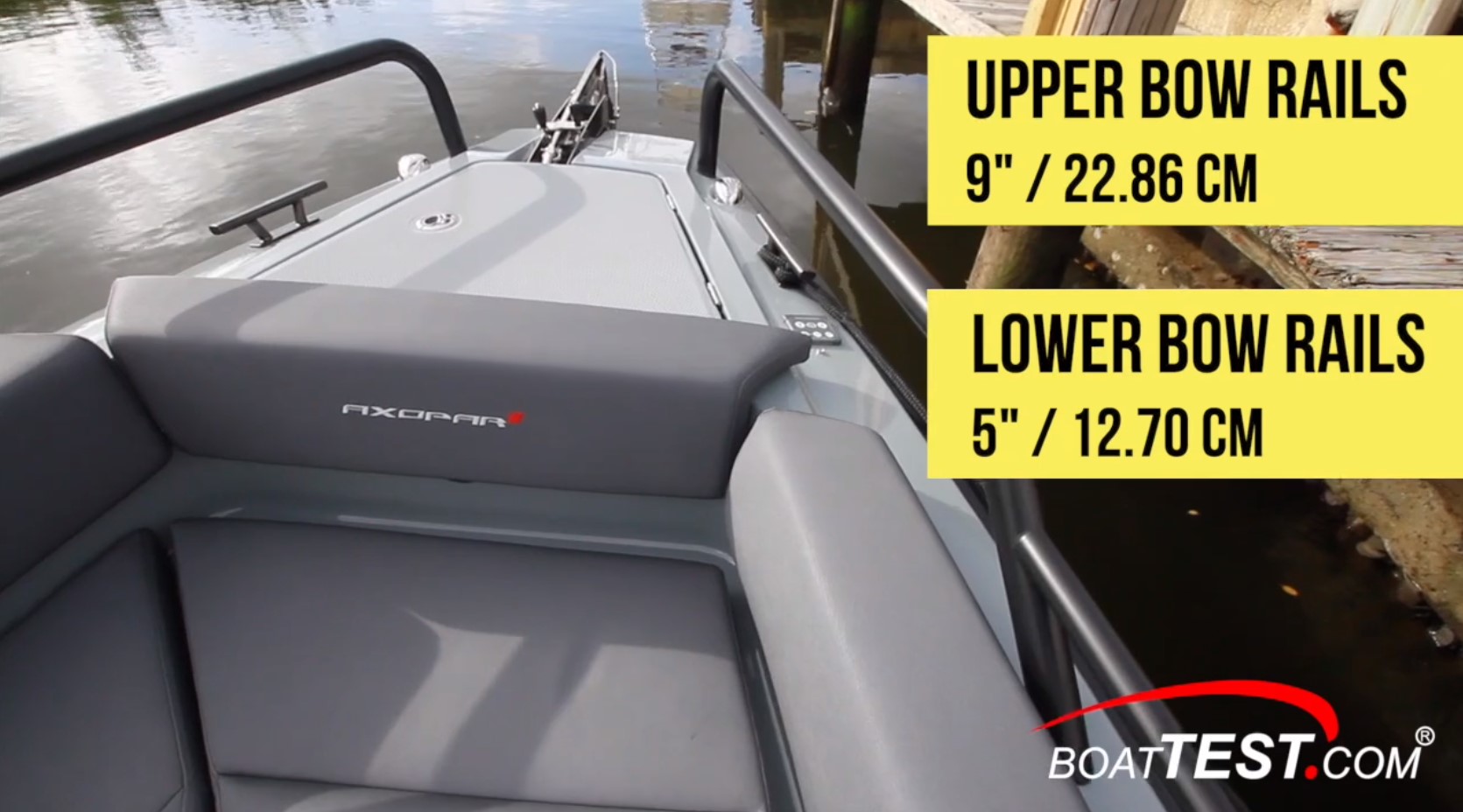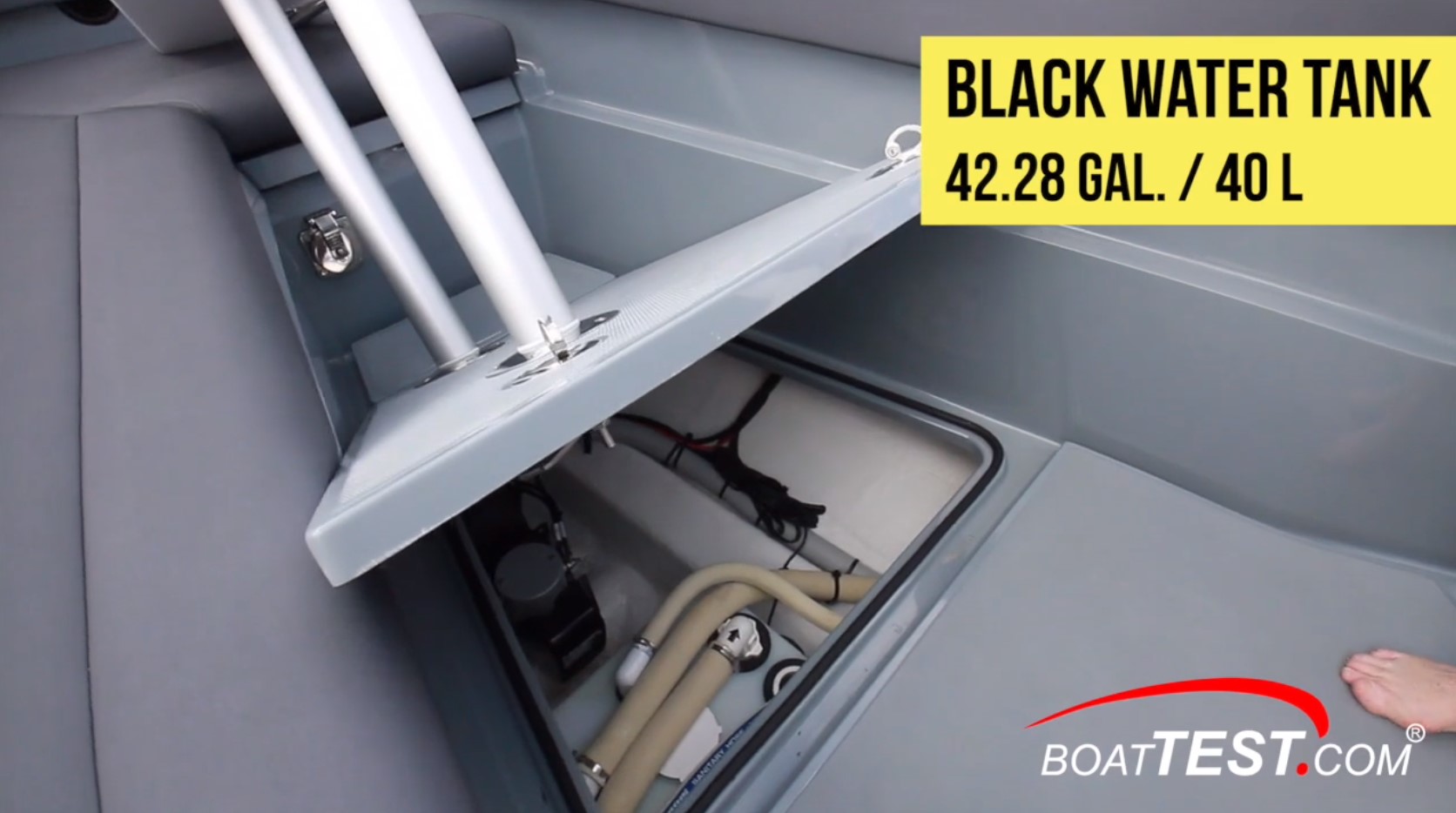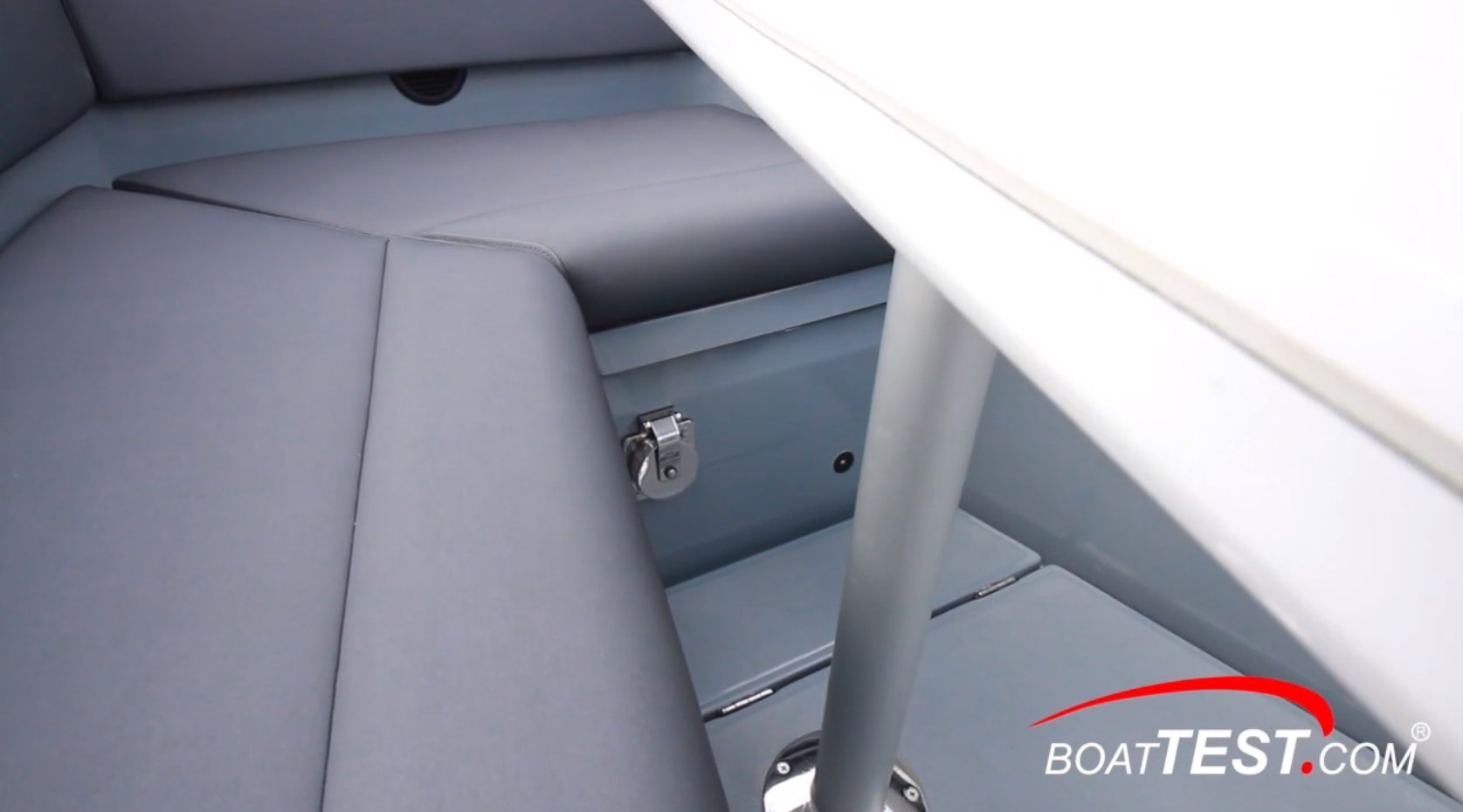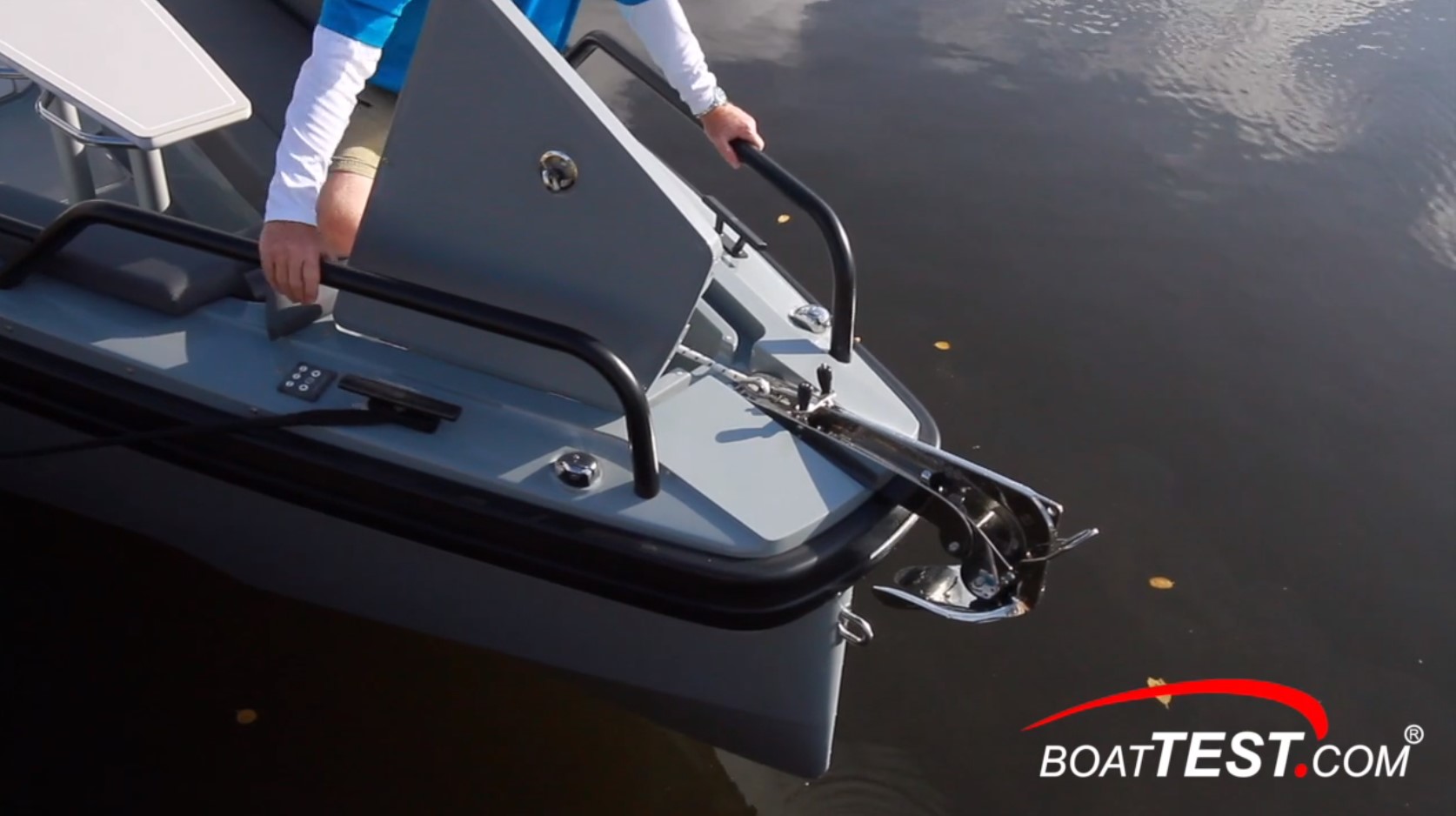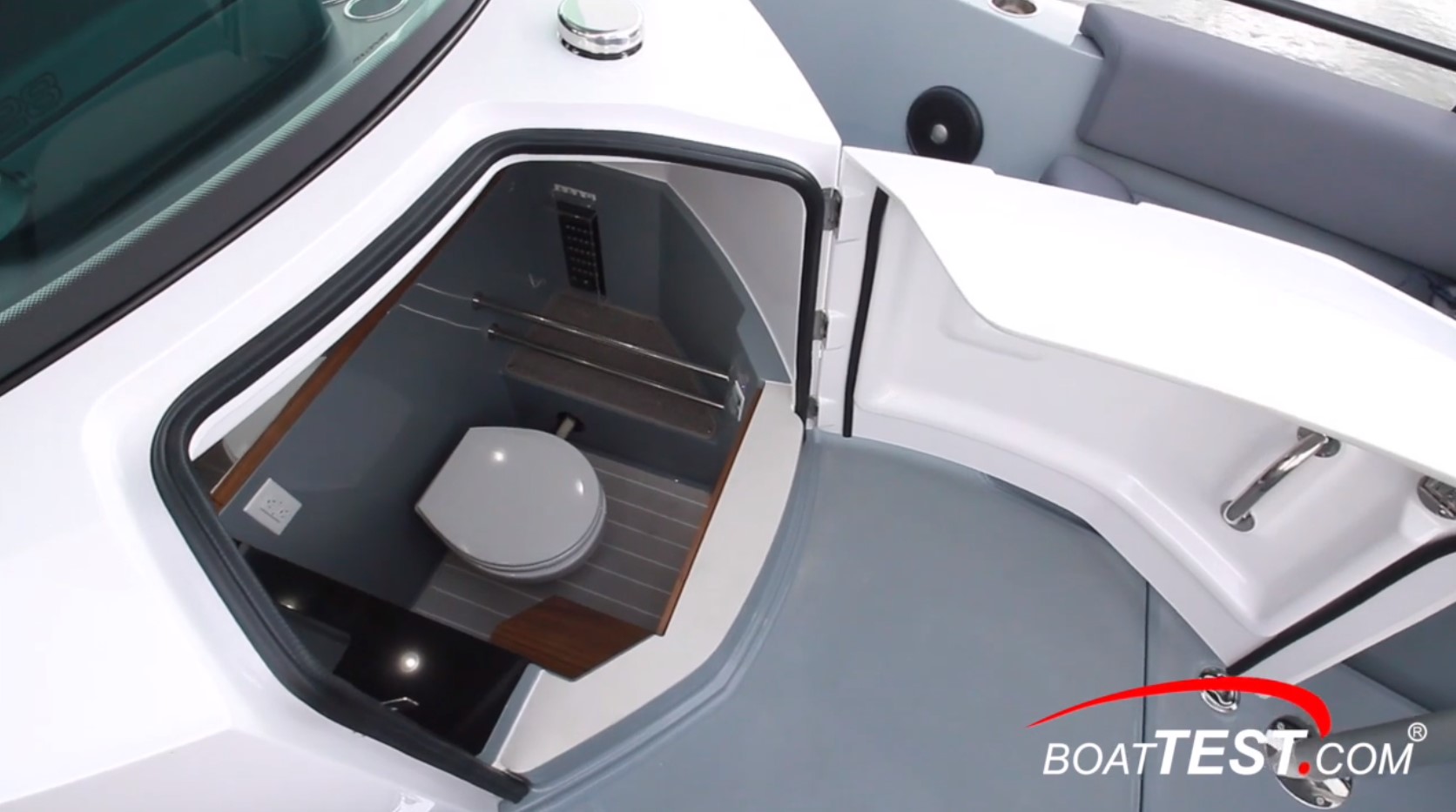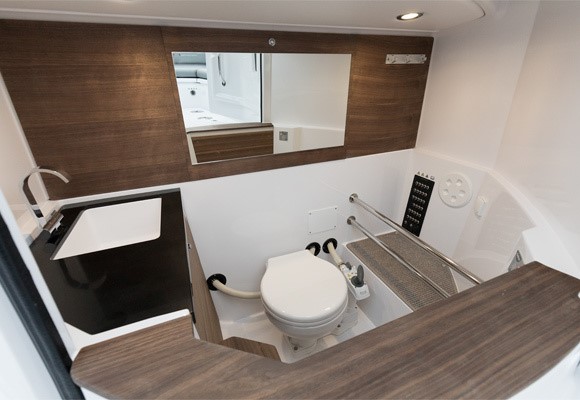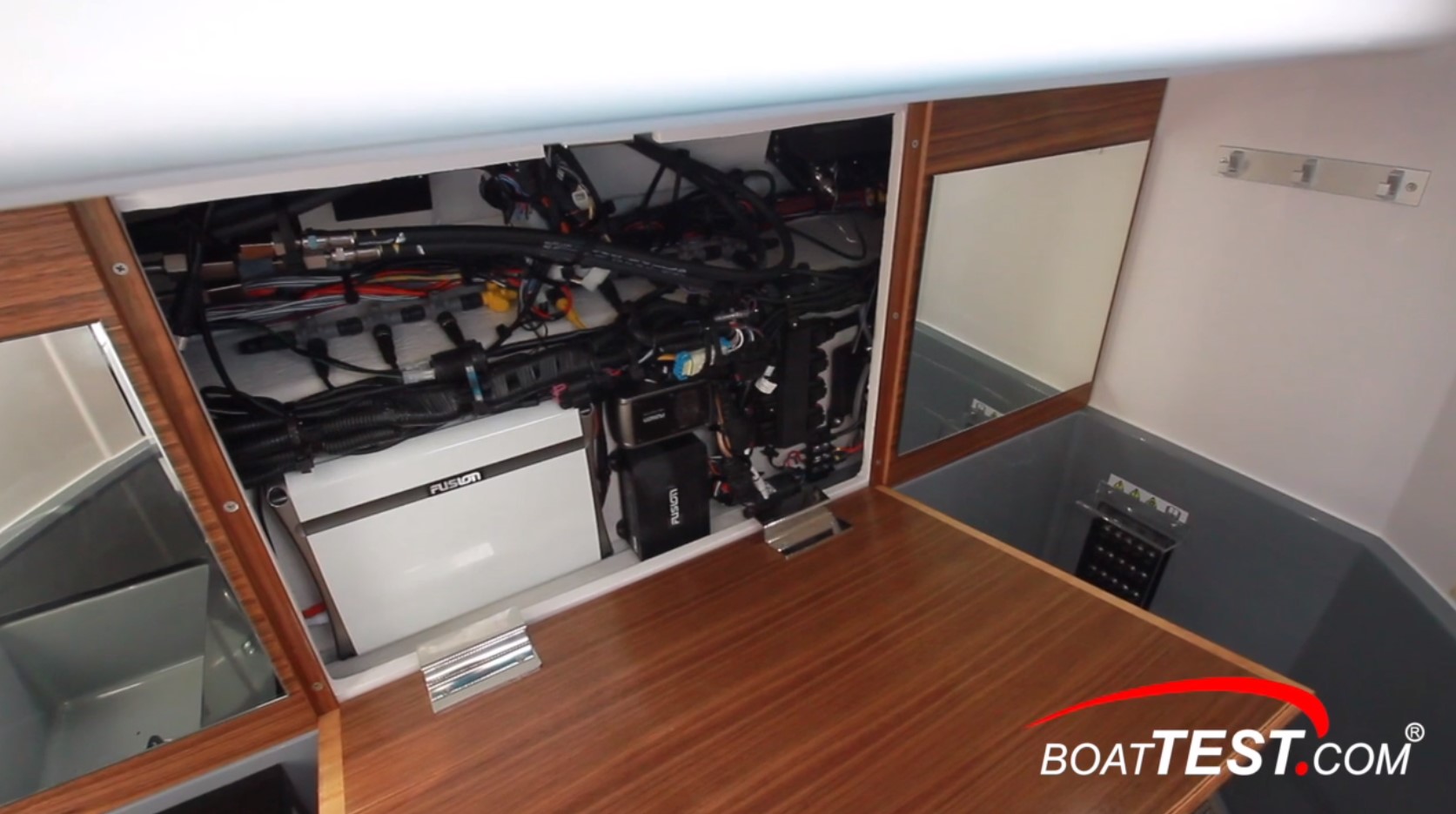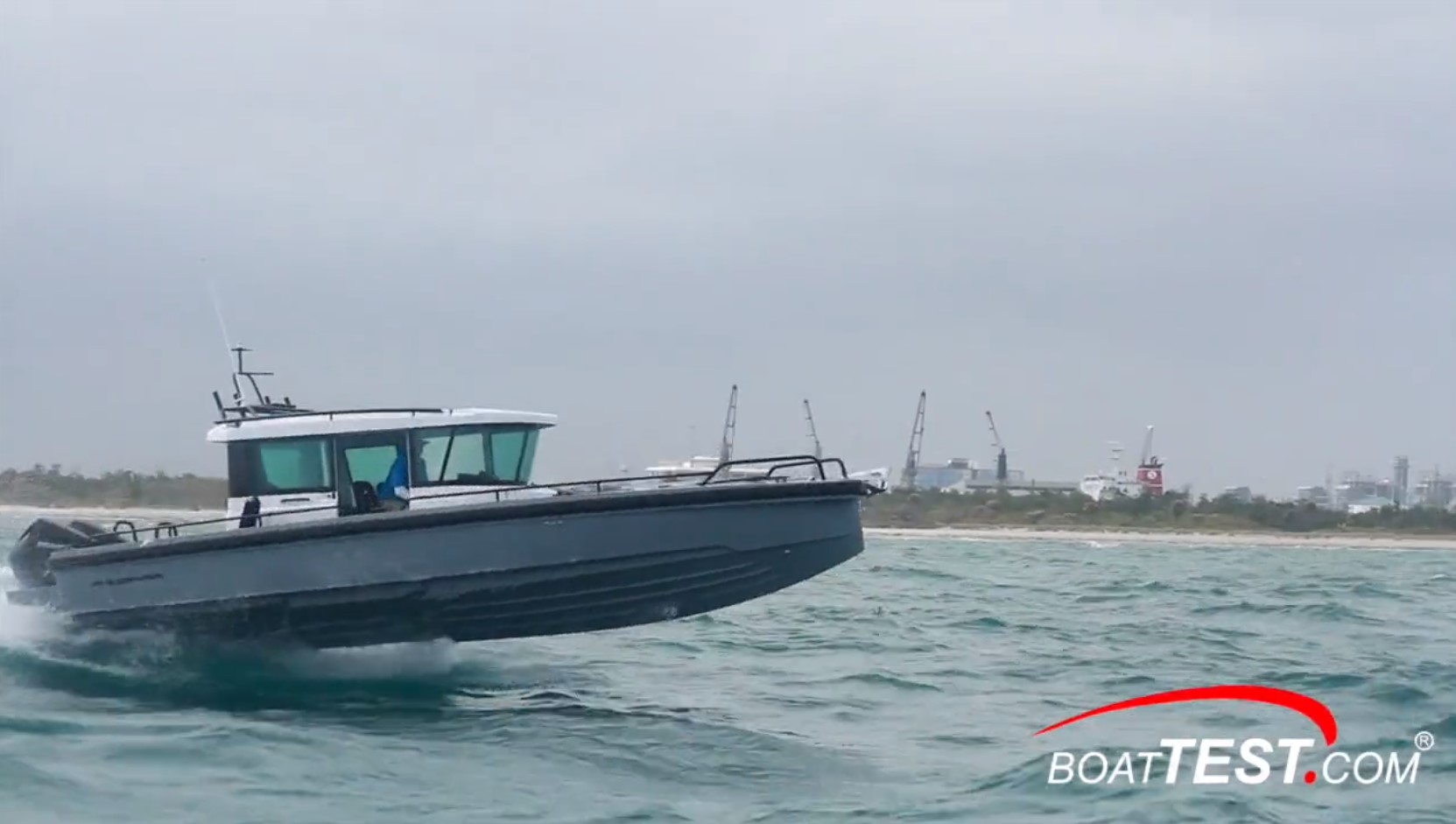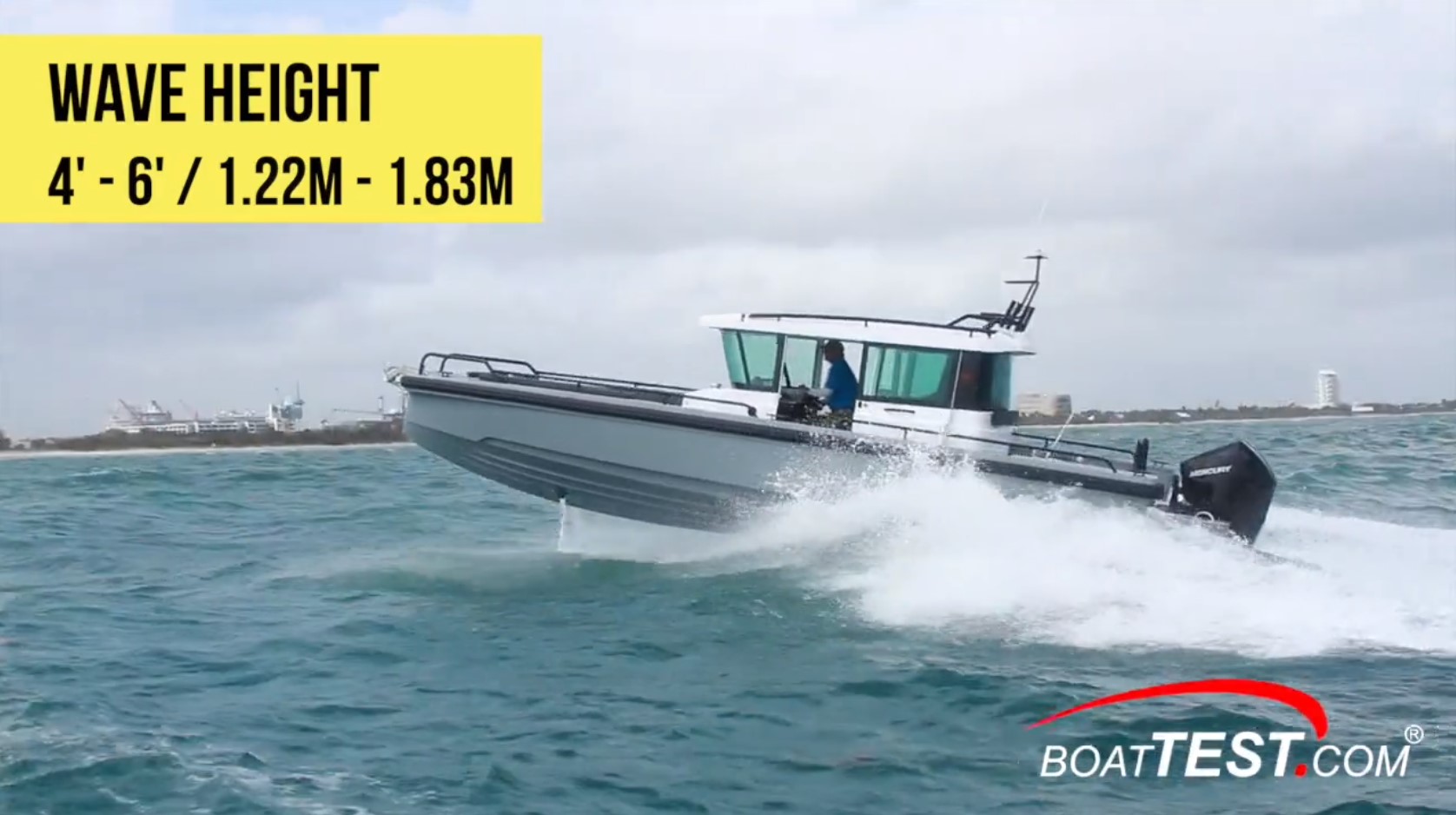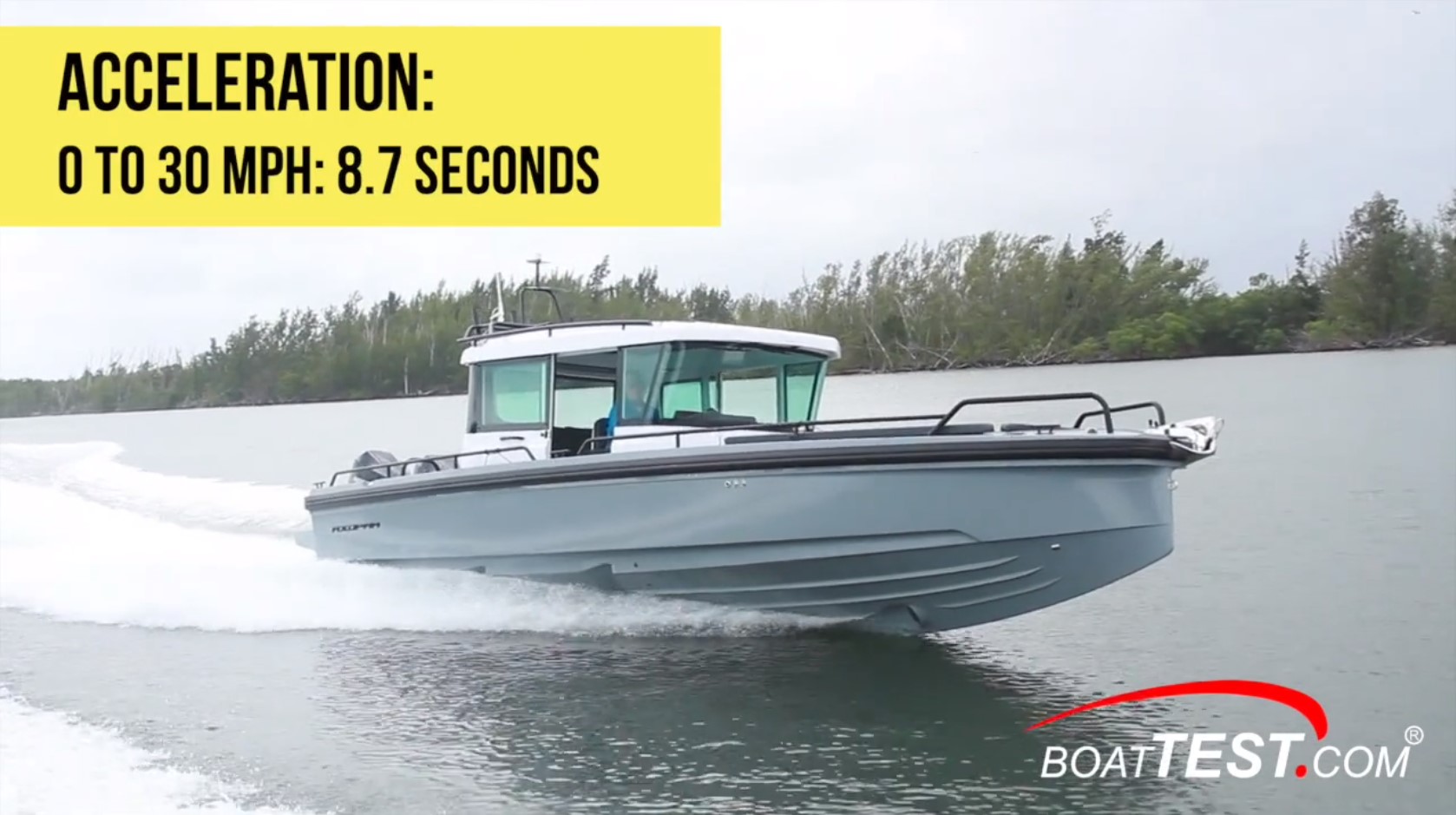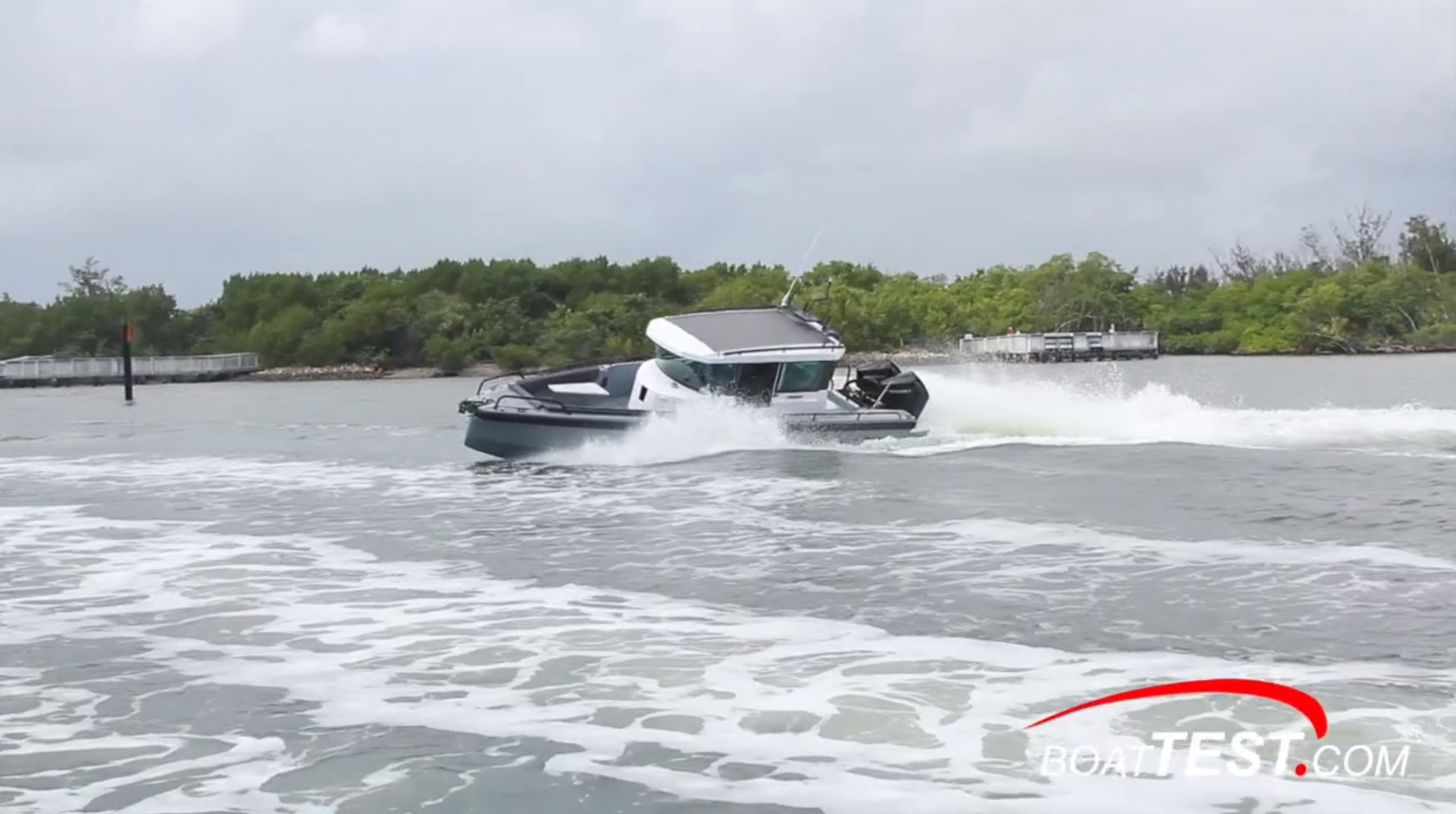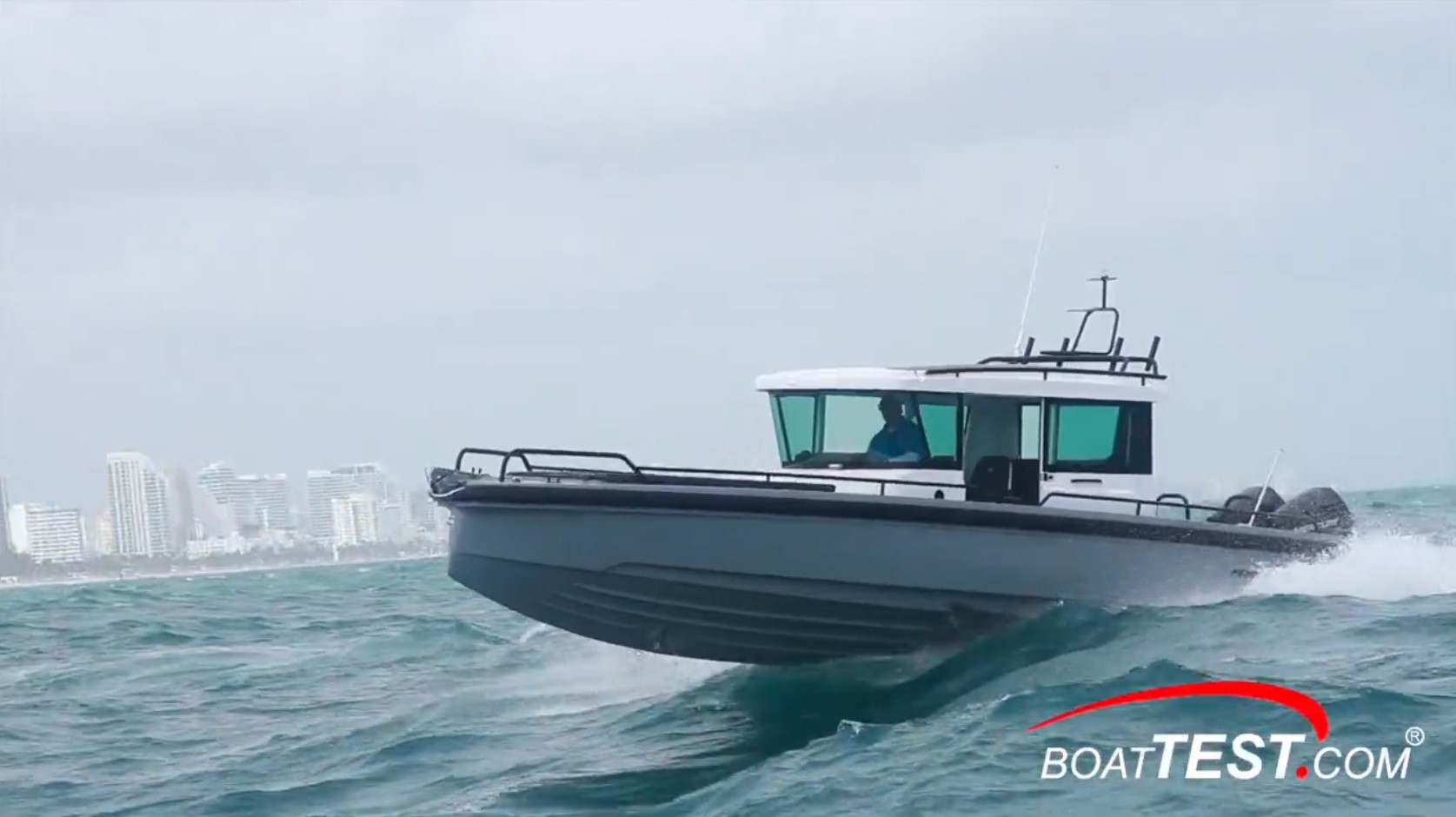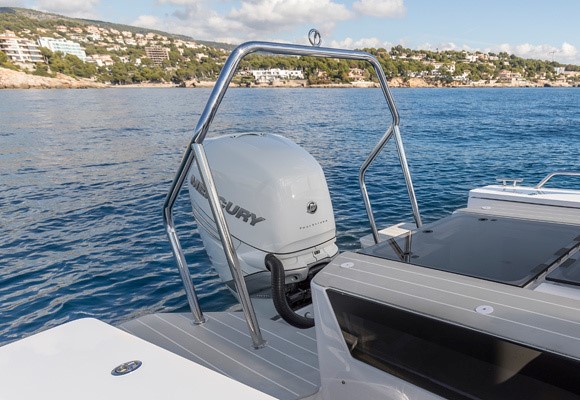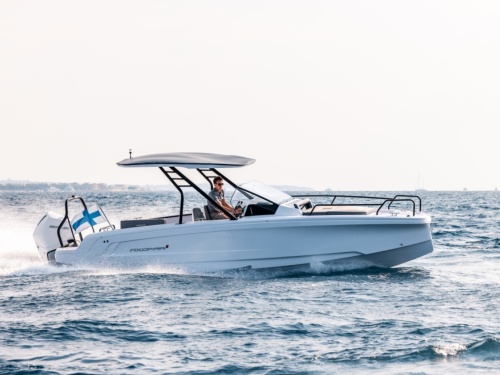Access More Boat Tests
Already have an account? Login
Axopar 28 Cabin (2019-)
2 x 200-hp Mercury Verado
Brief Summary
We tested the Axopar 28 Cabin in 5’ to 7’ (1.52 to 2.13 m) seas in one of the roughest conditions we have ever tested a boat in, much less in one this size with an open bow. The Axopar line of open day and cabin boats is built in Finland, a country known for building rugged sailboats and powerboats.
Axopar has combined the pilothouse and open commuter/patrol boat concept popular in Northern Europe with the hull shape and styling that we have seen coming out of Southern Europe. These blunt-bow, slab-sided, open-transom, mostly day boats are being built all over Europe now. They range from the super-luxury Pardo brand (which we have tested) to the Axopar brand with models that are far more economical to buy. The Axopar brand is now available in the U.S.
Key Features
- Five-person seating capacity
- Cabin offers occasional sleeping possibilities for one or two
- Webasto manual sliding canvas roof
- Walkaround side access and aft-deck
Test Results
| RPM | MPH | Knots | GPH | MPG | NMPG | STAT. MILE | NM | dBa |
|---|---|---|---|---|---|---|---|---|
| 600 | 3.2 | 2.7 | 1.2 | 2.6 | 2.3 | 161 | 139.7 | 52 |
| 1000 | 5.3 | 4.6 | 2.1 | 2.5 | 2.2 | 154 | 134.3 | 59 |
| 1500 | 7.7 | 6.7 | 3.6 | 2.2 | 1.9 | 132 | 114.7 | 65 |
| 2000 | 9.3 | 8 | 6 | 1.6 | 1.4 | 95 | 82.7 | 65 |
| 2500 | 15.3 | 13.3 | 8.1 | 1.9 | 1.6 | 115 | 100.2 | 74 |
| 3000 | 23.3 | 20.2 | 10.4 | 2.2 | 2 | 137 | 119.5 | 76 |
| 3500 | 31 | 26.9 | 13.7 | 2.3 | 2 | 138 | 120.2 | 77 |
| 4000 | 38.1 | 33.1 | 17.8 | 2.1 | 1.9 | 131 | 114.1 | 79 |
| 4500 | 44.1 | 38.3 | 22.5 | 2 | 1.7 | 120 | 104.2 | 81 |
| 5000 | 49.6 | 43.1 | 30.6 | 1.6 | 1.4 | 99 | 86.3 | 82 |
| 5500 | 55.5 | 48.3 | 34.8 | 1.6 | 1.4 | 98 | 85 | 82 |
| 5700 | 55.9 | 48.6 | 35.5 | 1.6 | 1.4 | 96 | 83.8 | 83 |
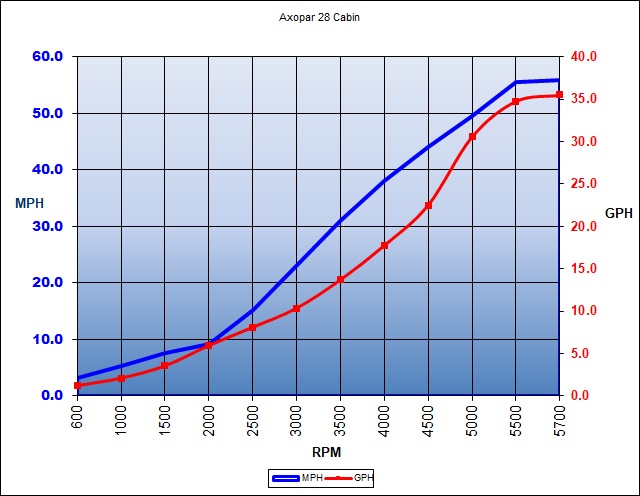
Specifications
| Length Overall |
30' 9.18 m |
|---|---|
| Beam |
9' 8" 2.95 m |
| Dry Weight |
4,277 lbs. 1,940 kg. |
| Tested Weight |
5,698 lbs. 2,585 kg |
| Draft |
2' 8'' .80 |
| Deadrise/Transom | 22-deg. |
| Max Headroom | open |
| Person Capacity | 9 |
| Fuel Capacity |
68 gal. 257 L |
| Total Weight |
5,698 lbs. 2,585 kg |
Acceleration Times & Conditions
| Time to Plane | 4.4 sec. |
|---|---|
| 0 to 30 | 8.7 sec. |
| Props | 13.6x21 Enertia |
| Load | 3 persons, 4/5 fuel, no water, 50 lbs. of gear |
| Climate | 68 deg., 60 humid; wind: 5-10 mph; seas: 0 |
Engine Options
| Tested Engine |
2 x 200-hp Mercury Verado |
|---|---|
| Std. Power |
1 x 250-hp Mercury Verado |
| Opt. Power |
1 x 350-hp Mercury Verado |
 Learn More
Learn More
Watch Our Video
Contents of Report
- Mission
- Distinguishing Features
- Major Features
- Design
- Construction
- Boat Inspection
- Cabin
- Helm
- Stern
- Sidedecks
- Bow
- Ground Tackle
- Head
- Performance
- Handling
- Equipment Discussion
- Price
- Optional Equipment
- Engine Options
- Other Options
- Observations
Mission
Gunkholing is an old term that references exploring along the coast into small out-of-the-way places. The Axopar 28 Cabin would be a perfect vessel to accomplish this: shallow enough draft, necessities for overnighting, offshore capability for runs in open water with surprising performance but with protection from the elements. If trips along the coast lead to a busy marina, the Axopar 28 Cabin will attract attention. Think of it as Euro-style meets practical Finnish utility.
The Axopar Back Story
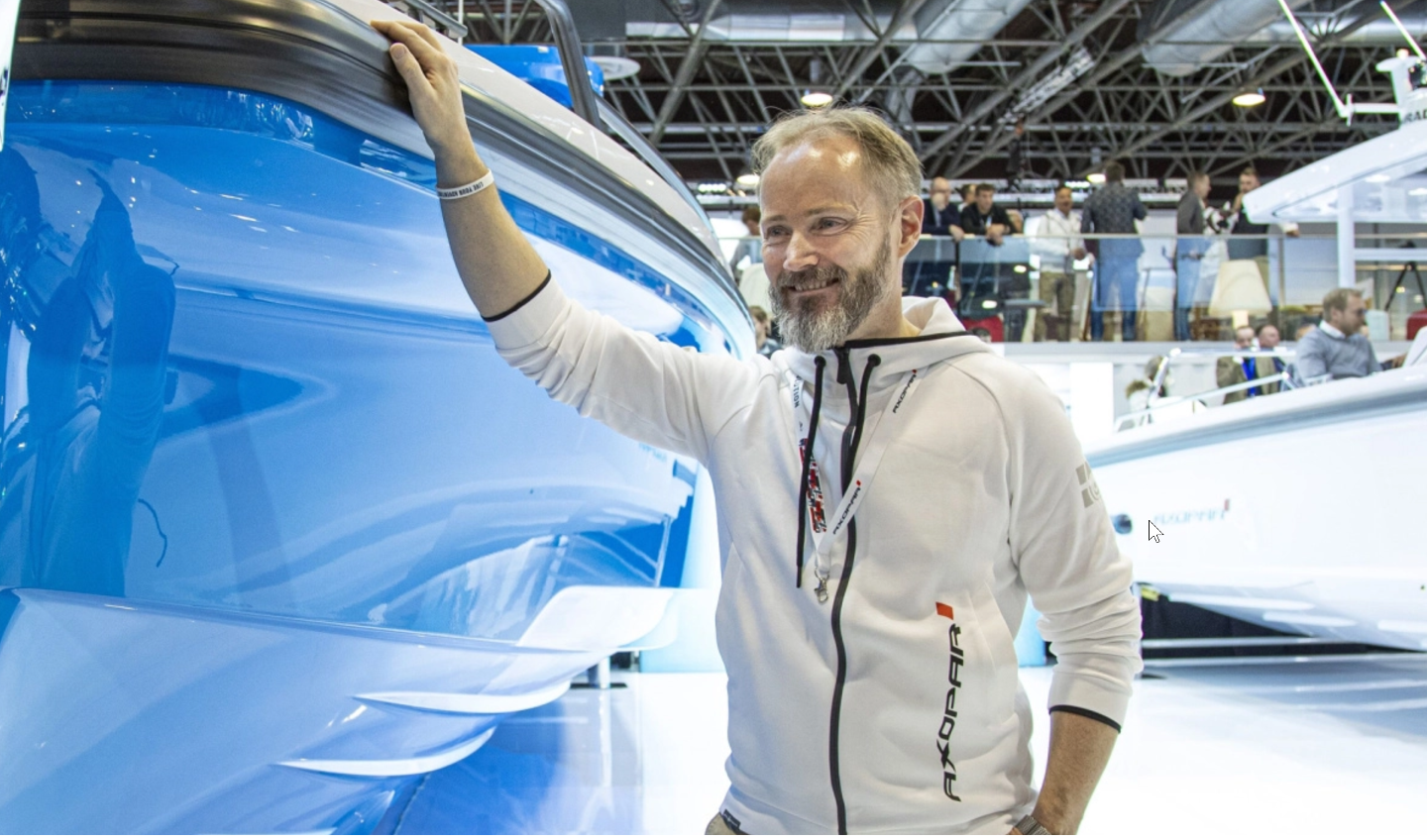
Read about the Axopar concept based on interviews with the company’s CEO, Jan-Erik Viitala here...
Distinguishing Features
- Plumb extended bow
- Enclosed cabin center console
- Pleated fabric retractable sunroof
Major Features
- Outboard powered
- Enclosed cabin center console
- 2-step hull design
Design
The design priority of the Axopar 28 Cabin was the 2-step V-hull design with plumb bow. As with any center console, the ability to comfortably walk around the exterior of the console is a requirement. This limits the interior volume of the cabin and its contents, so the design engineers had to be creative with amenities – and they were. The solution, in many cases, was to design things that could be converted from one use to another – such as converting the cabin seating to a double berth. Many builders employ this dual-purpose approach but not many push the limits like Axopar – an example is locating galley items like a refrigerator and sink in non-traditional places (under the helm seats). Performance aside, these design decisions resulted in a functional boat to weekend or overnight on.
Construction
Axopar is headquartered in Finland but has an office with full-time employees overseeing construction at their facility in Poland where the boats are built. Some 750 boats of all sizes roll out of this plant each year and are distributed to the 67 dealer networks worldwide.
Axopar burst into the market in 2014 and the 28 was their first model. The onsite engineers have helped implement many tooling upgrades to the 2018 and later models, including making subtle changes to the Axopar 28 Cabin’s length (+130 mm), width (+50 mm), hull sides (+80 mm), softening the spray rails and rounding the keel shape. In addition, they beefed up the stringer system and now use the same stringers as the 37-footers.
They’ve also improved the shape and water deflection on the bow thruster flanges added some non-skid on deck hatches and increased the size of the service hatch on the foredeck. The wrap-around windscreen glass has been upgraded to 6 mm safety glass and tinted a light green. There have been a host of other quality improvements over previous models which shows an engaged builder looking for perfection.
The boats are built with GRP material with Vinylester resin skin to prevent blistering. Captain Steve has inspected the fit-and-finish on our test boat and found it to be excellent.
Boat Inspection
The cabin has a huge manual sunroof and unobtrusive sliding side doors. Underway at 30-plus mph into any kind of headwind, most experienced drivers will close the doors to reduce wind noise and leave the top open – much like driving a sports car with the top down.
As we said, this is an interesting boat for several reasons, most noticeably because of her looks. Let’s face it, she’s an unusual design, but that translates into several features that make this boat a standout in her class, both at the dock and out on the water. She’s chock full of clever compromises between space and added features. But to us, the most significant factor is that this boat has an enclosed cabin, so let’s start here.
Cabin
The cabin is the first place where we get a glimpse of the upscale fit-and-finish on this boat. Teak is combined with carpeted decking, highlighting the premium attention to detail. Headroom is 6’3” (1.91 m) and windows are all around, including a large single piece aft window.
The overhead includes LED lighting mounted to suede panels and a massive manually opening sunroof.
Inside, the grayscale color tones are part of the Brabus package upgrade, and it looks great. Starting aft, there are dual seats that combined measure 5’2” (1.58 m) wide.
The aft seats in the cabin have a stainless footrest that doubles as a support for the filler cushion when converting the seating to berths.
Grab handles are at the overhead. Ahead, there’s a comfortable rail footrest and a side mount pedestal base that will accommodate a table. Storage pockets are behind the front seats.
With the helm seats swiveled sideways and the back seats folded down, an insert makes a double bunk.
The helm seats hinge forward to reveal a refrigerator (left) and sink. The bracket on the back of the fixed seat base is the mount for a teak table. The table stows under the rear seats and with the helm seats swiveled to face aft, a dining table for four is created.
Latches to the side of the front seat allow them to tilt forward exposing a sink to starboard and an electrically chilled cooler to port that is self-draining overboard. As we said, a clever balance between space and amenities.
Helm
There is 12” (30.48 cm) between the helm seats and cabin doors to facilitate moving about the cabin.
These forward seats continue the upscale design and upholstery and include flip-down armrests and flip-up bolsters – they can also swivel 360-degrees.
The left side of the helm console sports a Fusion stereo and a VHF radio below a suede-covered grab handle. Above is a storage cubby with connectivity plugs and beverage holders right alongside. To the right of the VHF are trim tab and bow thruster joystick controls.
The ergonomics of the helm, with an angled footrest to the tilt wheel and all controls within reach from a seated position, are superb.
At the helm panel, there’s a 12” (30.48 cm) Garmin display and a 7” (17.78 cm) Mercury SmartCraft display. All the electrical switches are spread out just below and all are lit when activated. The Mercury digital throttle and shift (DTS) engine controls is to the right of the wheel. The steering wheel is mounted to a tilt base and wrapped in the same suede upholstery as the rest of the cabin area, even including a branded suede center insert.
The joystick trim tab control is the most logical we’ve seen since it is a single joystick.
The rounded windshield is forward-raked to knock down glare. There’s also an 8” (20.32 cm) overhang, with wipers tucked under, providing additional shading to the helm.
The windshield wraps around and back to the doors to both sides. There are two mullions to the sides that do not hamper visibility. More importantly, the curved sections produce zero distortion. We see nothing but clear visibility.
Stern
Our test boat had the optional storage box with seat pad and bolster behind the single-pane aft window of the cabin.
A convenient grab rail is just under the overhang of the roof. A cushion and a padded bolster over the storage box translate into aft-facing seating. Underneath the snap-on cushions is storage.
An optional raised aft cabin in place of a storage box or wet bar is accessed behind the guest seats in the main cabin. When the ventilation/escape hatch is closed, a sun pad fits on top.
The aft deck measures 3’ x 6’8” (.91 m x 2.03 m) behind the deck storage box and is self-draining. To both sides are self-draining storage compartments with hatches finished on both sides and held up with gas struts. As they’re insulated, they can also serve as coolers and are available with optional refrigeration.
The storage compartment in the middle of the aft deck has access panels for fuel filters and water separators.
Under the deck is still more storage measuring 4’2” by 2’3” (1.27 m x .69 m). It’s big enough for skis and boards as the forward section continues under the deck for a length of 6’4” (1.93 m). The hatch includes a gas support strut and is finished on both sides.
The stern has staple rails with integrated angles. We can lift them out to open the area up for swimming, fishing, or maintenance. Being reversible, they can provide more room on the aft deck, or be positioned for tilting the engines out of the water. A ski tow arch is also an option.
Our test boat had a pair of Mercury 200-hp 4-strokes connected by a tie bar – the largest power the boat is designed for. The standard boat comes with a single 225-hp engine.
The flip-up cover on top of the Mercury outboards makes checkpoints easily accessible and if needed a handle lifts to facilitate removing the cowl.
To both sides are 3’1” (.94 m) swim platforms covered in Esthec non-skid matting. A retractable reboarding ladder is to port.
Sidedecks
The sidedecks are wide enough for walk-around space, and close enough to the helm to accommodate single-handed tie-ups on the amidships cleat.
Thirty-two-inch (81.28 cm) wide sliding doors to both sides provide access from the cabin to the sidedecks.
The black rails on the cabin top, cabin door, and on top of the cap rail are part of the Brabus package upgrade.
Moving forward there are grab handles to the cabin side and a rail along the cabin rooftop. The sidedecks measure in at 14” (35.56 cm), the bulwarks come up 24” (60.96 cm), and the rails top out at 29” (73.66 cm).
Bow
The bulwark at the forward end of the side deck has speakers and cup holders to both sides. The head door has a blacked out window and a metal vent cap overhead.
The bow features a social zone that consists of an L-shaped bench seat to port that continues across the bow.
The bow settee’s Silverstone upholstery is part of the premium upgrade package. A table adds to the area’s functionality and dual grab handles are to the starboard side of the table. With the bench only to one side, we have access to the foredeck while maintaining fixed seating – again, a clever balance of functionality and amenities.
The bow rails start at a height of 5” (12.70 cm) and increase to 9” (22.86 cm) at the working end of the bow.
Nine inch (22.86 cm) padded bolsters serve as backrests and wrap all the way around the bow.
Naturally, there’s storage under the seats that includes dedicated storage for the table and pedestals.
The pedestal table on the bow drops down on shorter legs to form part of the base for the filler cushion to turn the bow into a sun pad.
Under the deck hatch there’s access to the power steering pump, the bow thruster, and the boat’s black water holding tank.
Here’s an unusual location for a 120V shore power connection.
An optional bow cover adds protection to the area when not in use.
Ground Tackle
The controls for the Side-Power windlass are on the deck just below Captain Steve’s hand.
The anchor locker hatch opens with a turn-and-lock latch. It’s held open with a gas assist strut. Captain Steve would like to see the hatch finished on the underside to match the fit-and-finish of the rest of the boat.
Inside is a Side-Power windlass. The polished stainless 16.53 lb. (7.5 kg) plow anchor rides in a recessed stainless-steel roller that extends beyond the stem and allows the hatch to be closed when deployed. Controls for the windlass are right alongside the hatch and to starboard. Two 8” (20.32 cm) cleats are to the sides and under the elevated rails.
Head
At the front of the deck house, the hatch to the head opens on a lift-and-lock latch and is held open with a magnetic catch. There’s a tinted window in the door, allowing natural light inside.
We can swing the door closed for privacy with the grab handle on the right.
Inside the head compartment is accessed via two 14” (35.56 cm) steps. The compartment includes 4’2” (1.27 m) of overhead clearance and 2’11” (.89 m) of sitting headroom and there’s a vent at the top. There are mirrors on the aft bulkhead and storage over to port.
The toilet package upgrades the toilet to a freshwater electric flush with macerator.
There are circuit breakers, along with the activation switch for the fresh water pump, protected by a plexi panel. To starboard there’s a solid surface counter with a sink recessed into it with contemporary fixtures. Plumbing access is underneath. Our test boat’s porcelain toilet includes an electric flush. Wood is all veneer with faux teak decking.
Behind the mirrors, a panel opens to provide access to the back of the helm panel to ease service and installation of electronics.
Performance
Flat water was satisfactory for initial testing, but Captain Steve couldn’t wait to get the Axopar 28 Cabin offshore.
The Axopar 28 Cabin proved itself offshore. With all of the changes to the 2018 and later models, the boat now has a CE category B rating, the highest rating for a boat under 40’ (12 m).
The Axopar 28 Cabin has an LOA of 30’ (9.18 m), a beam of 9’8” (2.95 m), and a draft of 2’8” (.80 m). With an empty weight of 4,277 lbs. (1,940 kg), 90% fuel, and three people and test power onboard, we had an estimated test weight of 5,698 lbs. (2,585 kg).
With the twin 200-hp Mercury engines turning 13.6 x 21 Enertia props and run up to 5700 rpm, our speed topped out at just under 56 mph. Best cruise came in at 3500 rpm and 31 mph. It was at that speed that the 13.7 gph fuel burn translated into 2.3 mpg and a range of 138 miles, all while still holding back a 10% reserve of the boat's 68-gallon (257 L) total fuel capacity.
The deadrise of 22-degrees aft helps the Axopar 28 Cabin run with a more bow up attitude.
We got on plane in 4.4 seconds with a 7-degree bow rise aided by her twin-stepped hull. We continued accelerating to 20 mph in 6 seconds, and 30 came and went in 8.7 seconds.
Acceleration
Time to plane: 4.4 seconds
Zero to 20 mph: 6 seconds
Zero to 30 mph: 8.7 seconds
Handling
The Axopar 28 Cabin is an excellent handling boat and a blast to drive.
Her plumb bow really extends the keel further forward so there’s very little slide in the turn. She comes around smartly, offering zero prop ventilation, and maintains her grip for a good acceleration as she straightens out. And it didn’t take long to figure that adding power in the turn tightens it up nicely with no loss of traction.
During normal running, her plumb bow is mostly out of the water. However, when running through seas, it’s a vastly different story. Then the bow should be fully engaged in making clean slices through the waves. We needed to see for ourselves, so offshore we went.
The long bow came into play in rough head-sea conditions slicing through waves.
As soon as we got into some heavier conditions, roughly 4 to 6 footers (1.22 m to 1.83 m). We knew this was something different. She really showed good characteristics in heavy seas. If we pushed, we could get her to pound but it didn’t take long to find that sweet spot in each direction where she was most comfortable.
It is not always easy to find a boat that handles well going both into waves and running before them. Captain Steve liked the Axopar 28 Cabin whichever way it pointed.
In following seas, we let her rip. The sharp entry cuts right through with no hint of stuffing the bow. Even when the boat gets buried in the trough she makes her way through.
In head seas, she’ll explode right through the waves or possibly catch air between the waves. At the right speed, she’ll just skip along and remain fairly flat, letting the bow do its work.
With beam seas, she’s also comfortable and easily accepts more power.
Down but not out, the Axopar 28 Cabin plays in the trough of a wave.
Equipment Discussion
Standard equipment includes
- Mercury 225-hp
- Toilet package
- Bow thruster
- LED lighting
- Windlass
- Shorepower 120V with 20ah charger (US)
- Side rails
- Trim tabs
- Freshwater system 12-gallon (45 L) tank
- Shower on aft deck
- Table in cabin, teak
- Table on bow, Esthec
- Targa arch with roof rails
- Garmin VHF
- Garmin Sonar module
- Fusion entertainment system
- Garmin chartplotter
- Sunbrella Harbor cover for foredeck
Price
Base price: $132,322
Optional Equipment
The boat is available in several premium paints, decking, and upholstery packages, Silvertex, Version R, and Brabus. East Coast Yacht Sales, the Axopar dealers from Maine to Maryland told us that most people are ordering the boats with bigger single engines, cabin heaters, and the aft cabin, while Florida boats tend to be ordered with the two-engine option and A/C. For import reasons, dealers are adding some options, like trailers and A/C stateside.
Engine Options
- Mercury Verado 300-HP upgrade ($4,950)
- Mercury Verado 350-HP upgrade ($10,555)
- Twin 200-HP Merc upgrade ($17,525)
- Custom engine options are available upon request.
For water skiing or tubing, the Axopar 28 Cabin can be equipped with a tow arch.
Other Options
- Webasto cabin heater ($3,770)
- Rod holders for Targa arch ($1,326)
- Electrical Webasto sunroof system ($2,444)
- Waterski tow arch ($689)
- Walnut wood floor in cabin ($702)
- Refrigerator in aft port storage ($1,027)
- Anti-fouling paint ($1,742)
- A/C with inverter ($9,200)
- Aft deck bench with stowage ($1,976)
- Wet bar aft ($2,704)
- Cooktop for wet bar ($572)
- DayCruiser aft cabin ($5,326)
Observations
This boat was really a lesson in not judging a book by its cover. Our first take was that she’s certainly an unusual design. But once we stepped aboard, we were impressed with her fit-and-finish. As we started to explore, we were impressed by the balance between available space and functionality. Once we got her out on the water, her handling had us hooked. This boat has a lot to offer and is sure to attract many more in the same way.

